When we think of Champassak, it is often the famous Vat Phou which comes to mind. And for good reason: this former Khmer temple listed by UNESCO, perched on a hill overlooking the Mekong, is worth the detour in itself.
But beyond Vat Phou, the region has other beautiful surprises in store. I suggest you a two-day loop from Pakse, to discover another side of southern Laos: the quiet charm of old Champassak, crossing the Mekong to the peaceful island of Don Daeng and its beach, a temple lost in the woods, and finally a refreshing break at the edge of an isolated waterfall.
Day 1 – Vat Phou and Champassak
Since I'm not a morning person, I didn't leave early that morning. Moreover, I took my time before leaving Pakse, by taking a quick stroll through the old town, just to see some colonial architecture houses (I talk about it in my article dedicated to Paksé) and especially have breakfast in a local cafe (the Vida Bakery Cafe).
On the road to Vat Phou
I left Pakse shortly before 11 a.m., skirting the small mountain of Wat Phousalao on the outskirts of the city before taking the small country road along the Mekong. I then found myself following a road, framed on my left by houses from the few villages I passed through, while on my right, the landscape was mainly composed of rice paddies with the Pasak Mountains in the background.
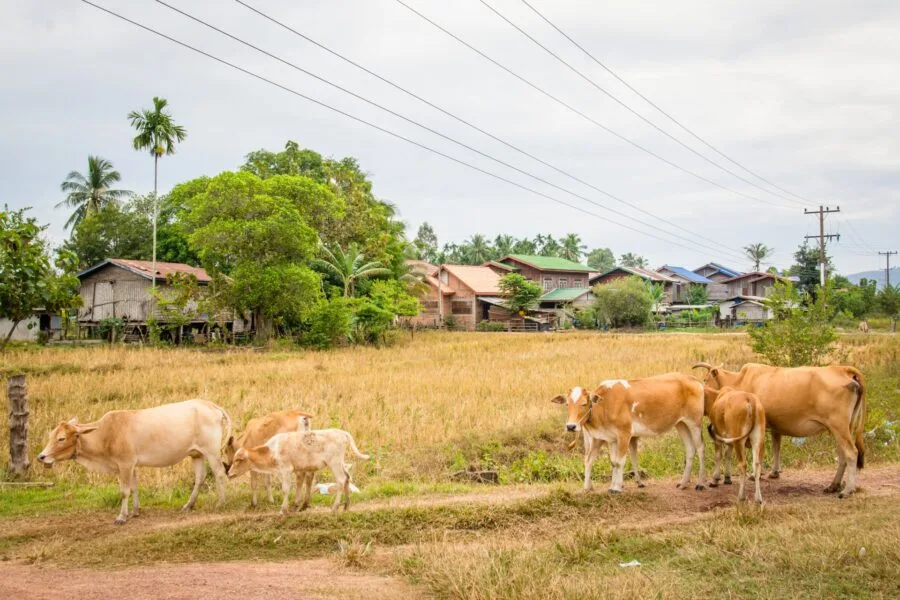

Since it's only a 45-minute drive from Pakse to Vat Phou (also spelled Wat Phu), I take my time and stop regularly to take a few photos. Whether it's the houses, the cows wandering around, or the roadside vendors, everything is an excuse to stop for a few seconds.
At one point, I venture a little deeper into a village, just to see local life and, in particular, to reach the banks of the Mekong. At this time of year (November), the water level is low enough to allow locals to exploit the moist, fertile soil on the banks of the river, creating veritable agricultural gardens.

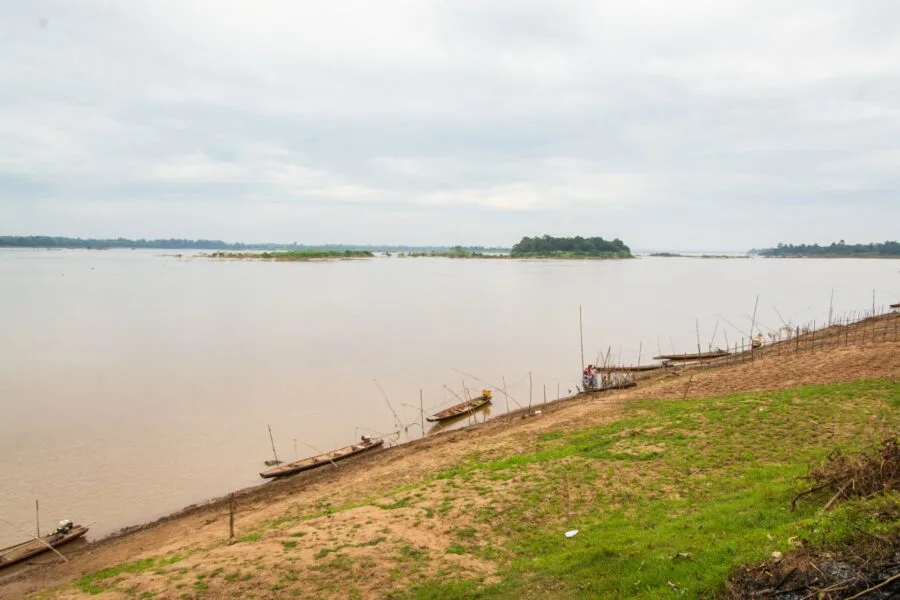


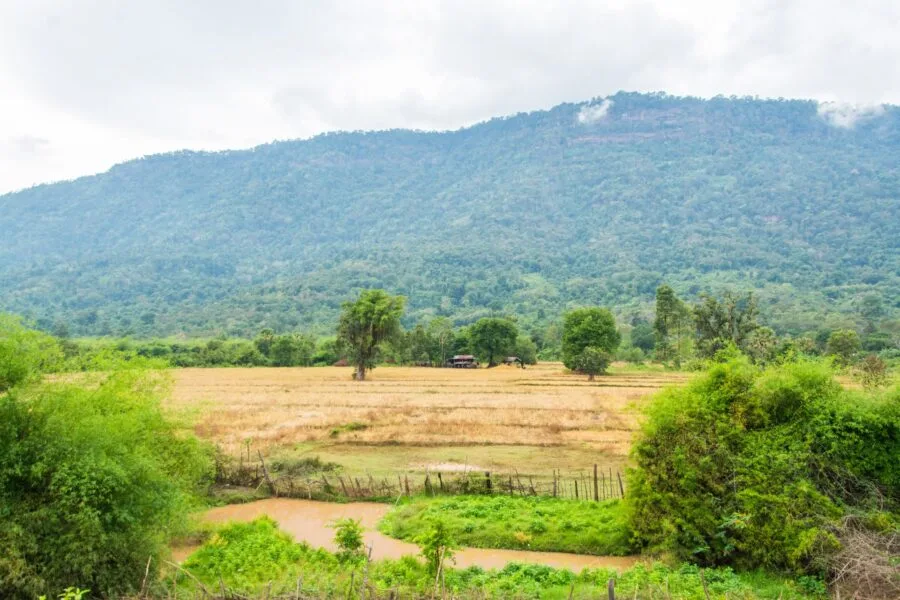
I've been gone for less than an hour when I reach my hotel (which used to be called The View at Champasak Resort but has since been renamed Jenda The View), located a little further south of Champassak. Since it's not even noon, I take the opportunity to check in; it allows me to put my things down and avoid lugging them around all day.
And given the time, I decide to stay and eat at their restaurant, which boasts a relaxing setting overlooking the Mekong. When I take off again from my base, it's past 14 p.m., but it won't even take me 10 minutes to reach the entrance to the Vat Phou site.
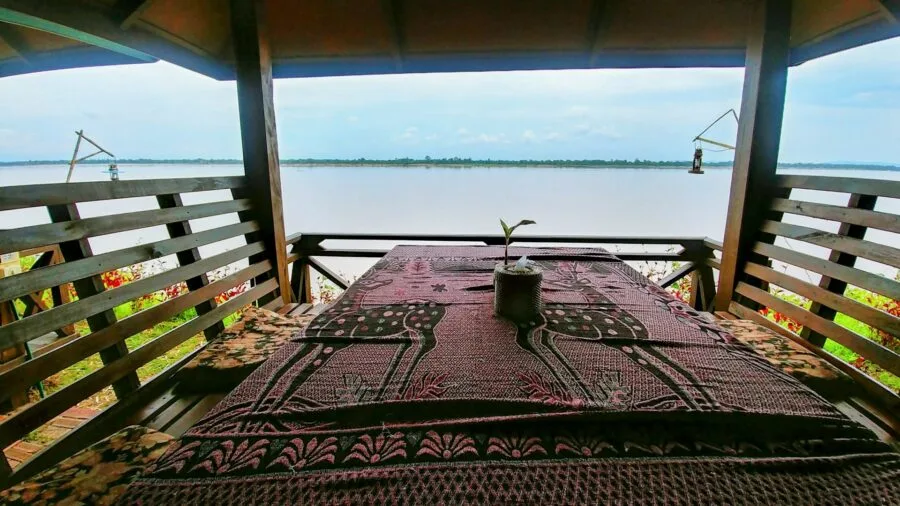
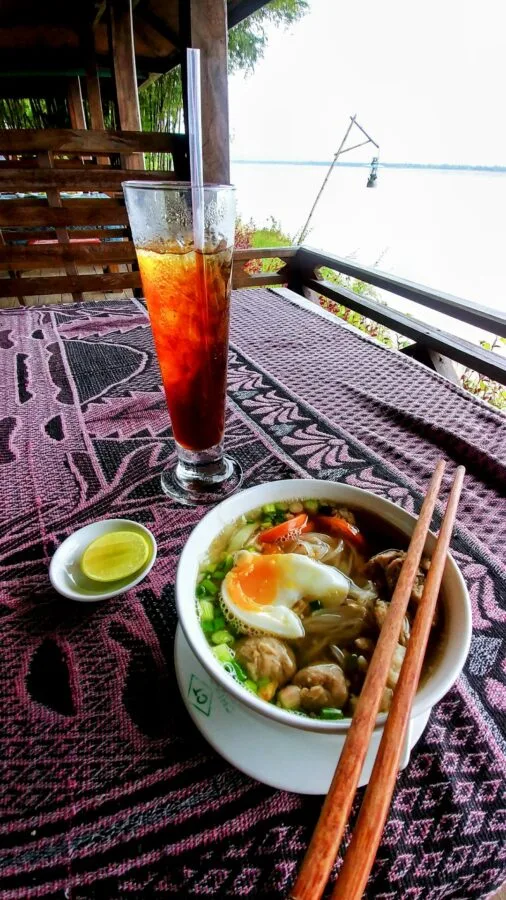
Vat Phou: a Khmer temple in the heart of southern Laos
Vat Phou (or Wat Phou, ວັດພູ) is an ancient Khmer sanctuary located at the foot of Mount Phou Kao, about ten kilometers from Champassak. It is listed as a UNESCO World Heritage Site since 2001, and considered one of the most important archaeological sites in Laos.
A glimpse into History
As I often do, I like to provide a little historical context to help you understand what's going on around you. It is worth noting that the site was already a sacred place in the pre-Angkorian era, with animist cults linked to the mountain, then Hindu cults around the god Shiva. The structures we see today date mainly from 11e and 12e centuries, at the time of the Khmer Empire, when Vat Phou formed a sort of “religious province” connected to Angkor by an ancient sacred road of more than 200 km.
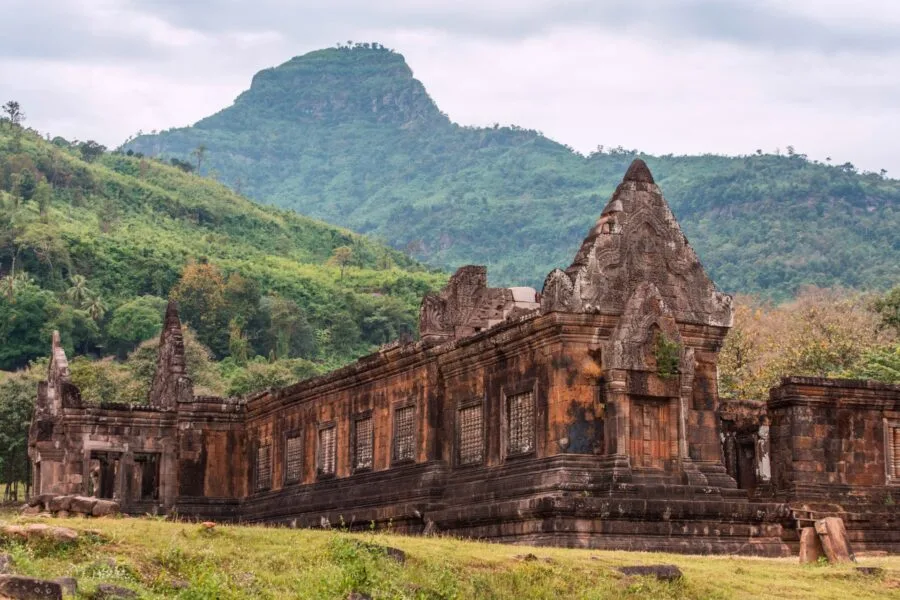
Among the notable structures on site, we find:
- artificial lakes called " barays",
- a monumental avenue framed by standing stones similar to lingams,
- two symmetrical buildings called the North and South Palaces (the North being also nicknamed " men's palace " and the south " women's palace"),
- stone stairs that climb the hillside,
- and at the top, the ruins of the main sanctuary and around, several sculpted rocks as well as a sacred spring, which is still flowing.
Beautiful panorama of the valley and the Mekong
What makes the site particularly striking is its setting: the temple is built against the Phou Kao mountain, recognizable by its peak (which rises to 1m), evoking the symbolic shape of the lingam associated with the deity Shiva - it is for this reason that it was chosen at the time.
At the reception, I quickly understand that we can't go any further by motorbike. So I leave my bike in the parking lot and climb aboard a shuttle, which takes me—alone—to the foot of the stone walkway. Along the way, we pass the large water basins, these reservoirs typical of the Angkorian era, with the silhouette of the mountain in the background.
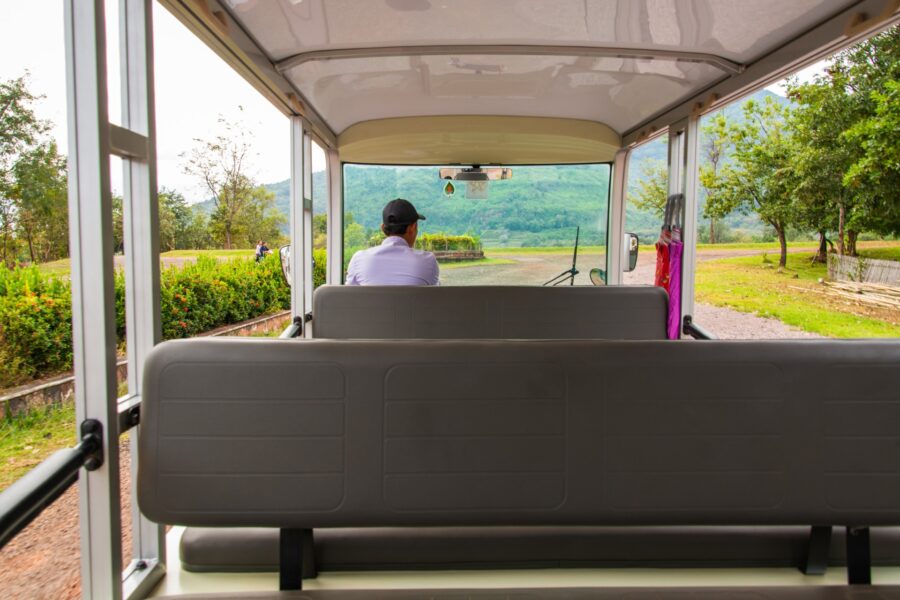
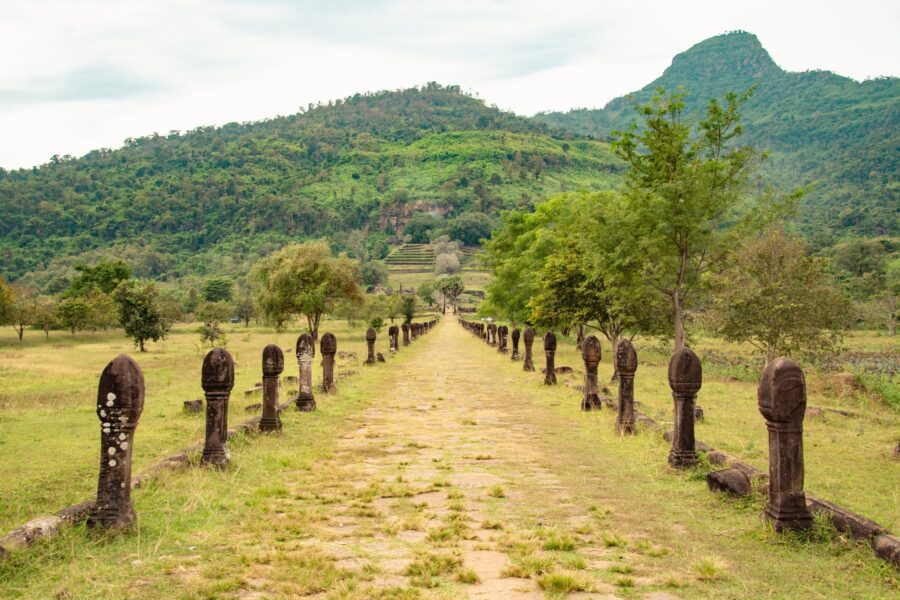
I cross this paved path for nearly 300 meters, oriented west-east—from the mountain toward the Mekong—in an atmosphere that truly gives the impression of going back in time. I then arrive at the two rectangular buildings, called the North and South Palaces. Since I don't see anyone at this point, apart from a few locals sitting in the shade of a palm tree, I almost feel like I have the site all to myself.
I finally meet my first tourists—Laotians—at the foot of the majestic staircase. You can tell these steps have been walked on for centuries: they've lived in them. You don't climb all at once, because the temple is built in terraces. After a first flight of steps, I arrive at a landing, with an altar on the side sheltering a statue under an umbrella. I can't tell if it's Shiva or Buddha, but the locals happily stop there to pray or leave offerings.
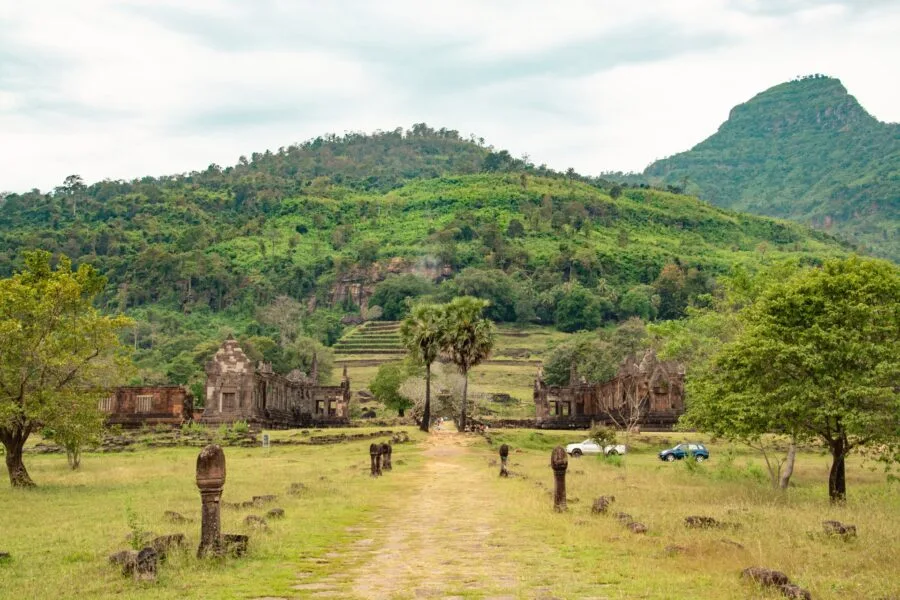

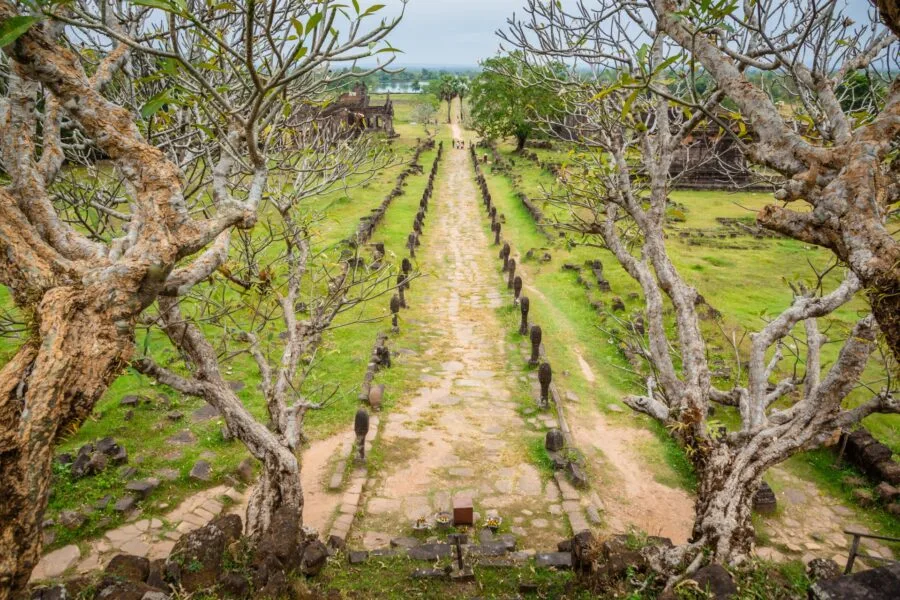
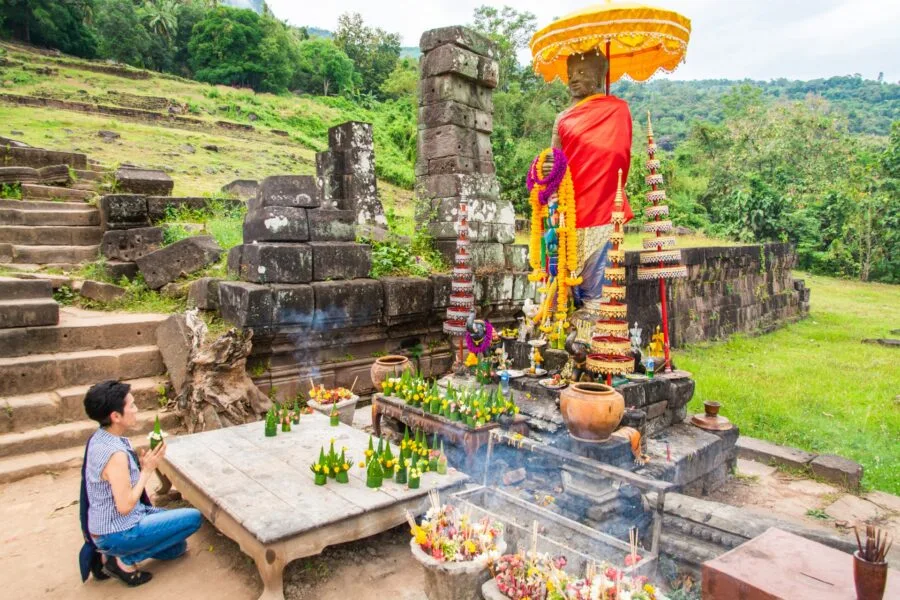

In front of me, the steps continue, framed by two superb frangipani trees with twisted branches. The slope is steeper on this last section, but the higher I climb, the more interesting the view over the plain becomes.
Below, the Mekong River plain stretches as far as the eye can see. At the very top stands the ancient sanctuary. A few ladies run a small stand there, selling flowers that worshippers still place there today. The place, despite its somewhat dilapidated state, retains all its sacredness. The atmosphere is peaceful and surprisingly untouristy.


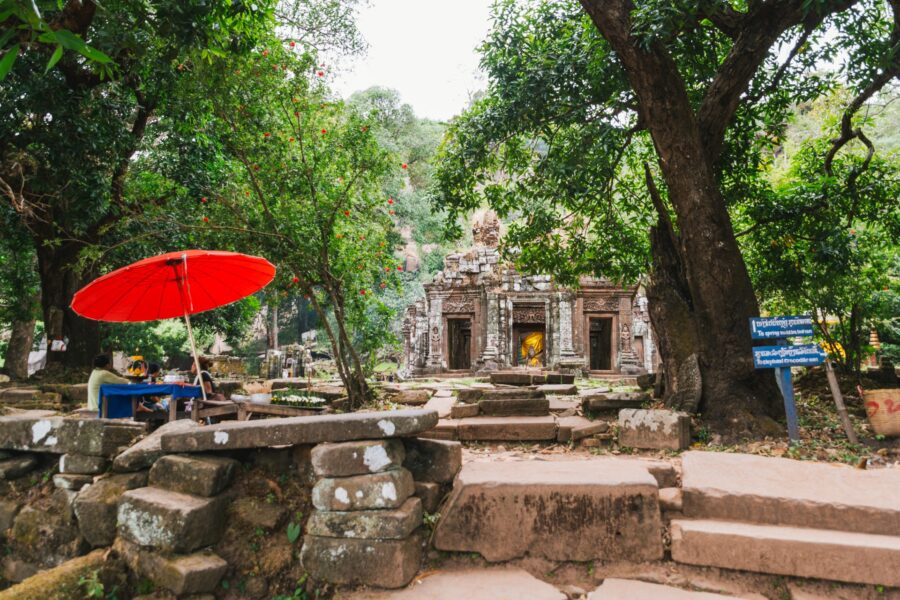
I explore the sanctuary almost alone. I admire the sculpted lintels above the doors and the finesse of the bas-reliefs, which are still clearly visible—including a depiction of a devata (female deity). Inside, a few expressive Buddha statues stand amidst offerings and incense sticks.

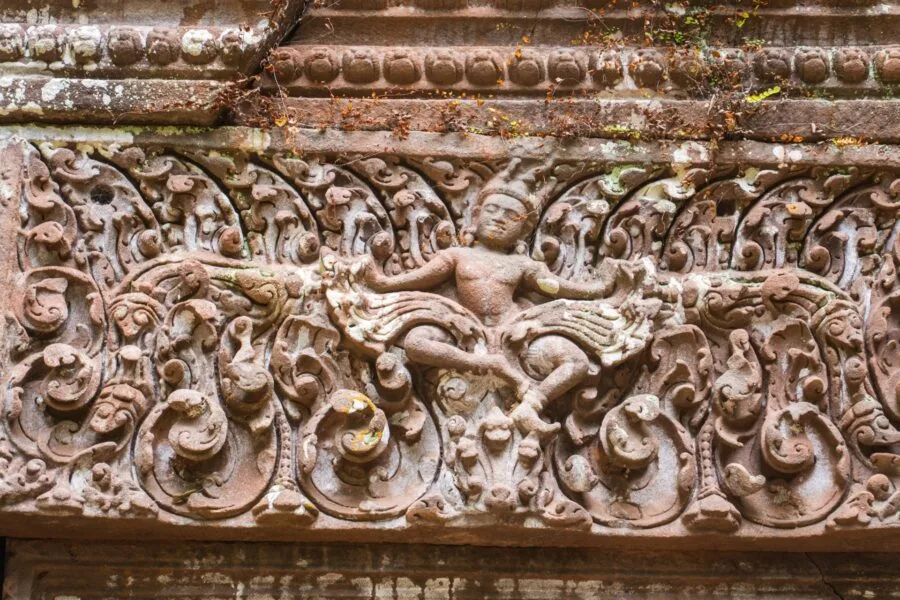
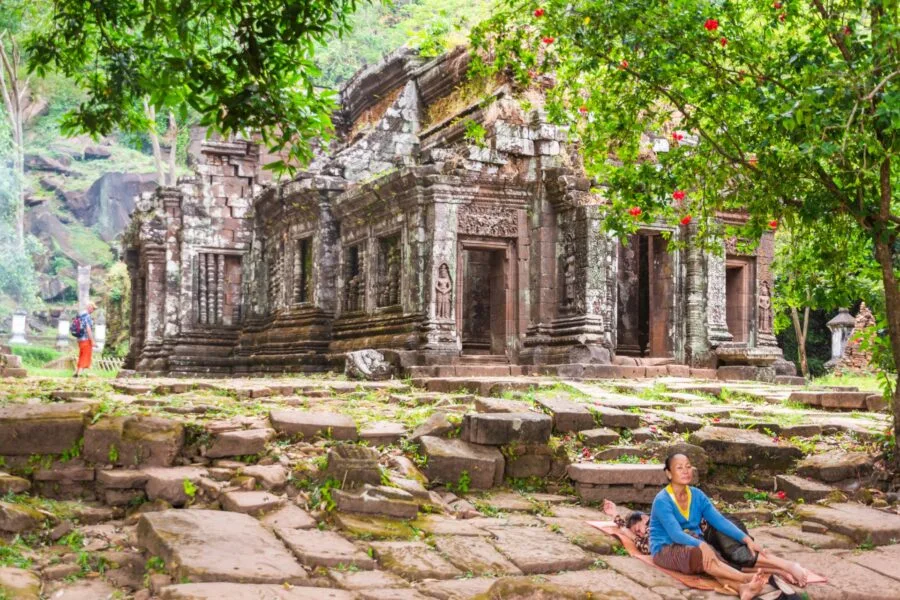
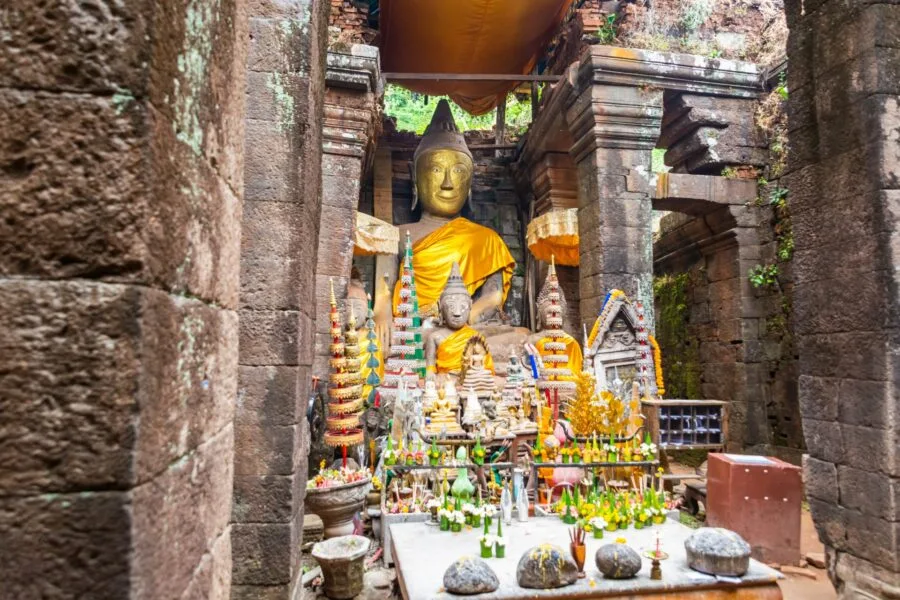
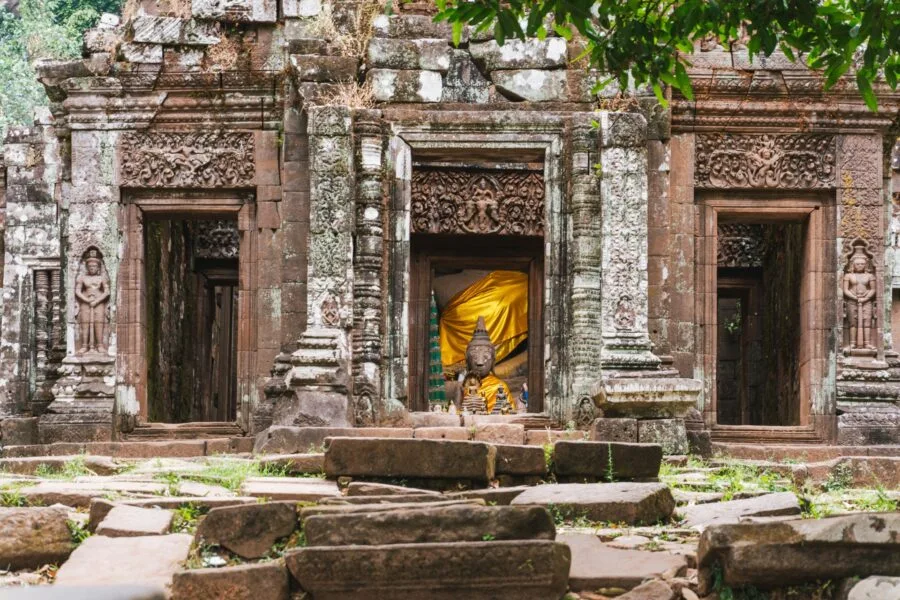
At the time of my visit, the sanctuary was still in its original state: the back half was completely overgrown. To the side, one can see the remains of what was once a small library, intended to house religious texts.
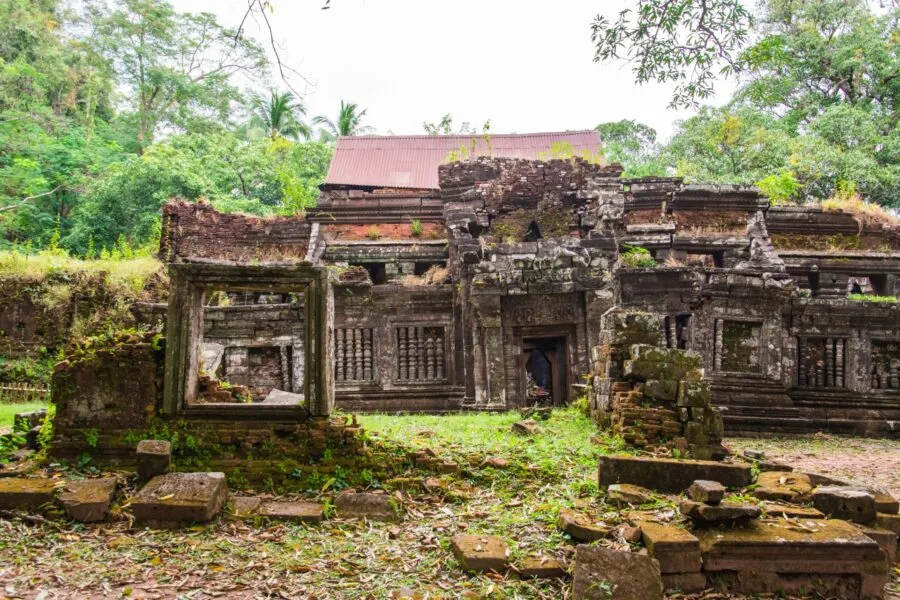
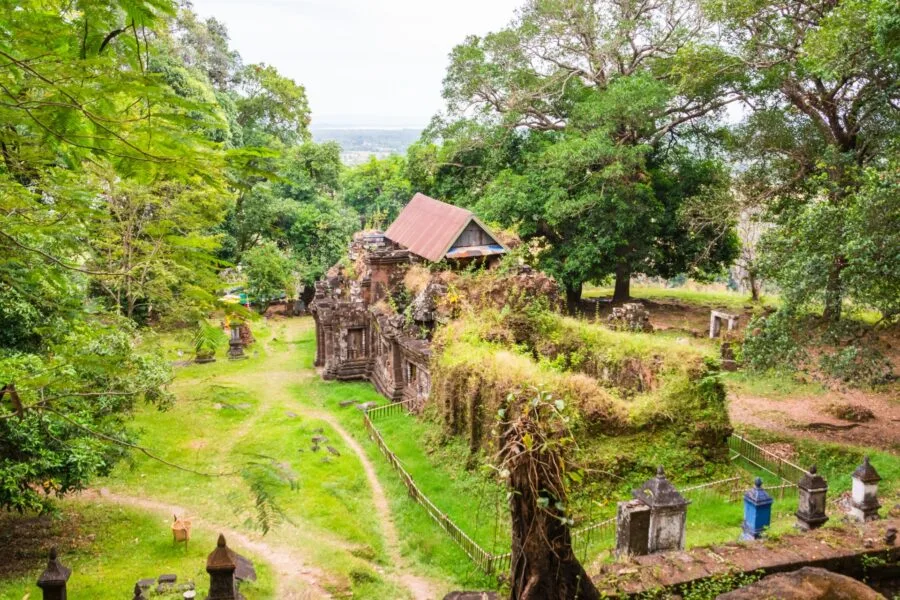
By climbing a little behind the temple, we reach the sacred spring, located at the foot of a huge block of rock. A stone gutter channels water into a basin carved into the rock, which still fulfills its function centuries after its construction.
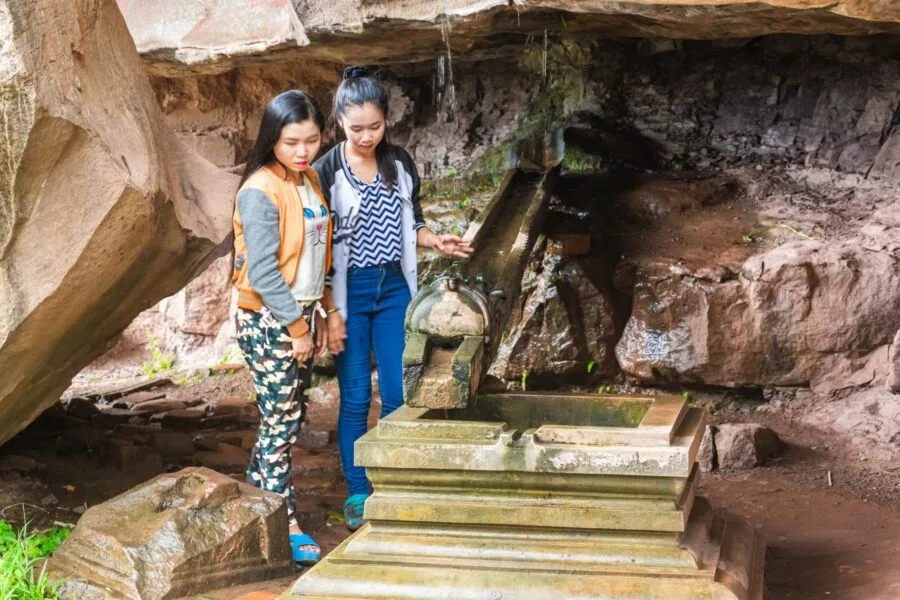
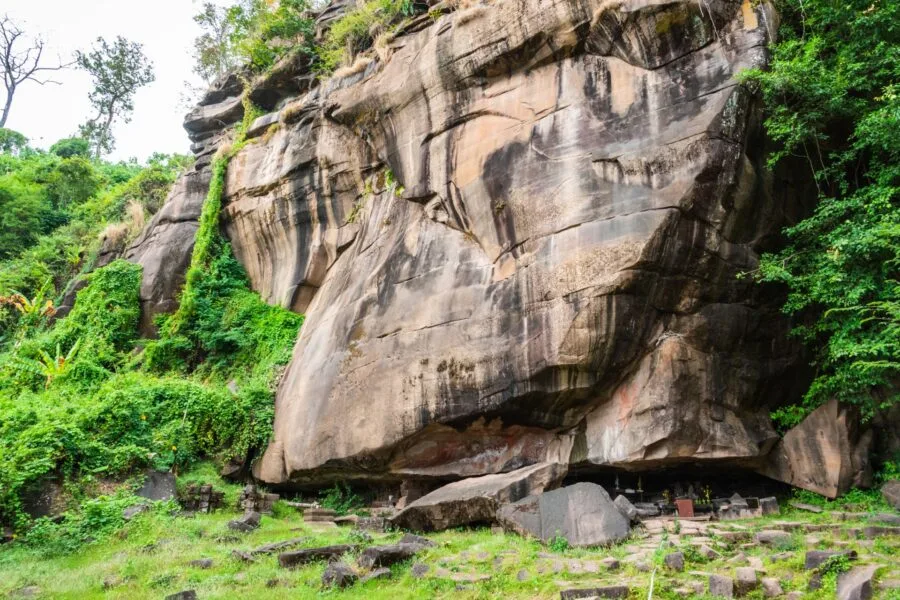
I don't know if monks still live there, but I come across a wooden dwelling on stilts, which probably served this purpose. Moving a little further away from the main area, I come across several sculpted rocks: some in relief, like theElephant Rock, others in hollow, like this giant lizard quite surprising. We can also see ancient steps, likely remains of other structures that have now disappeared.

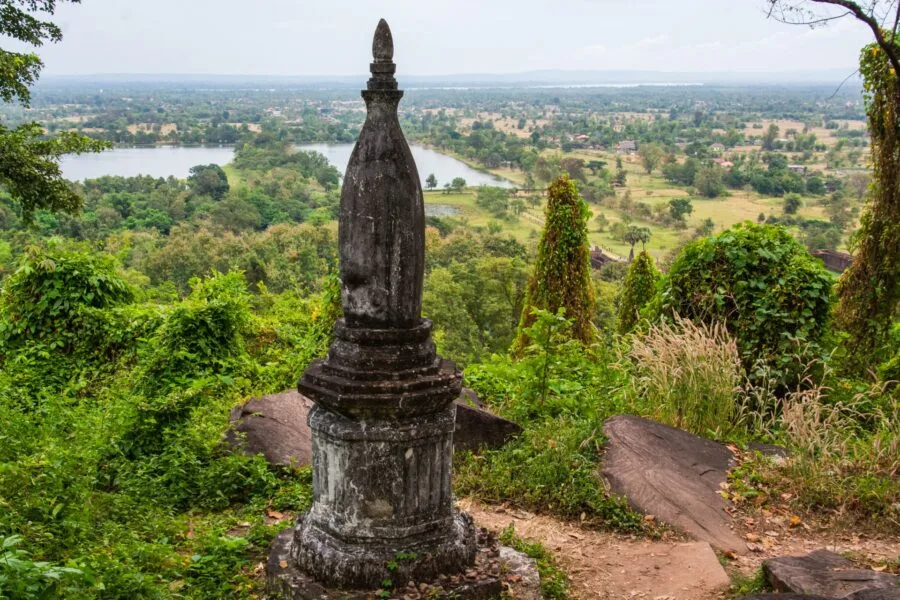
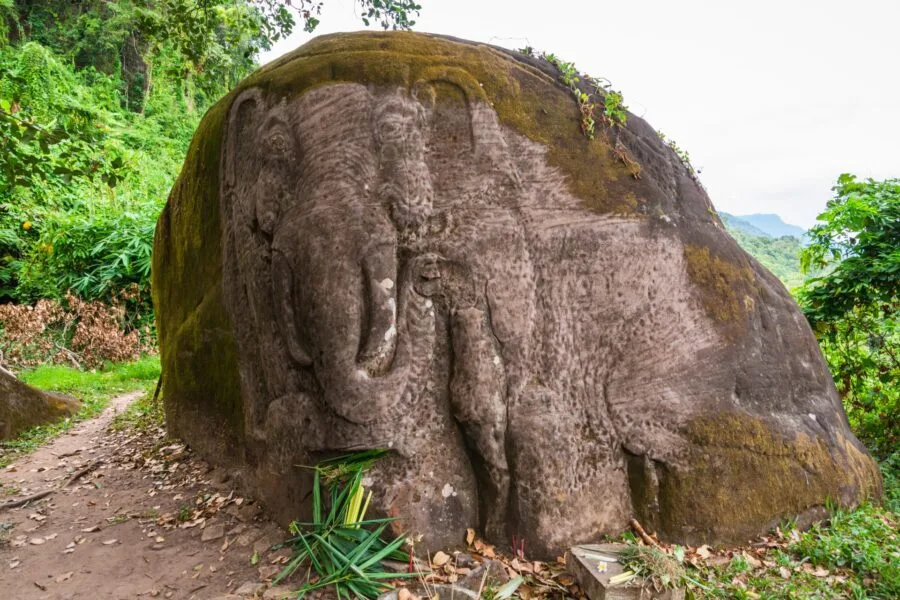
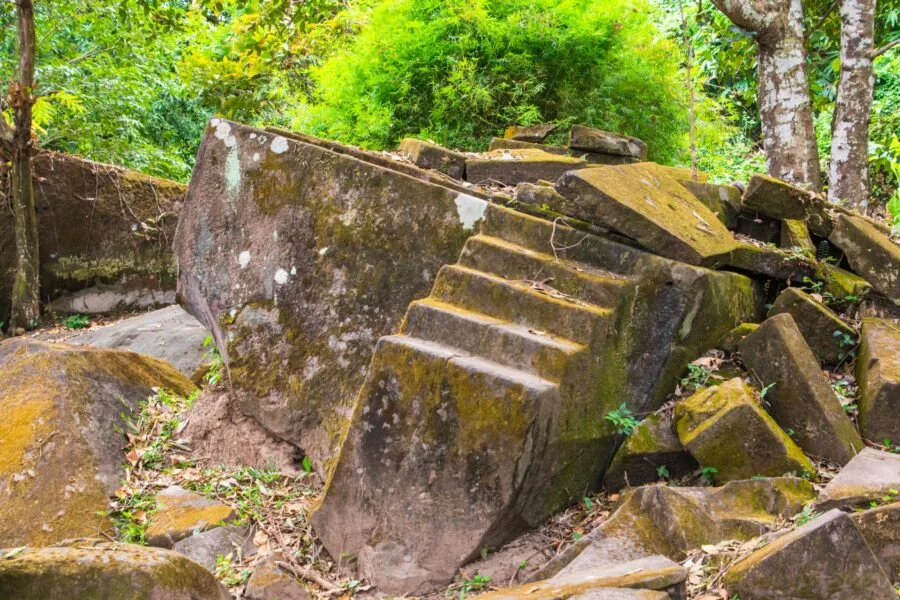
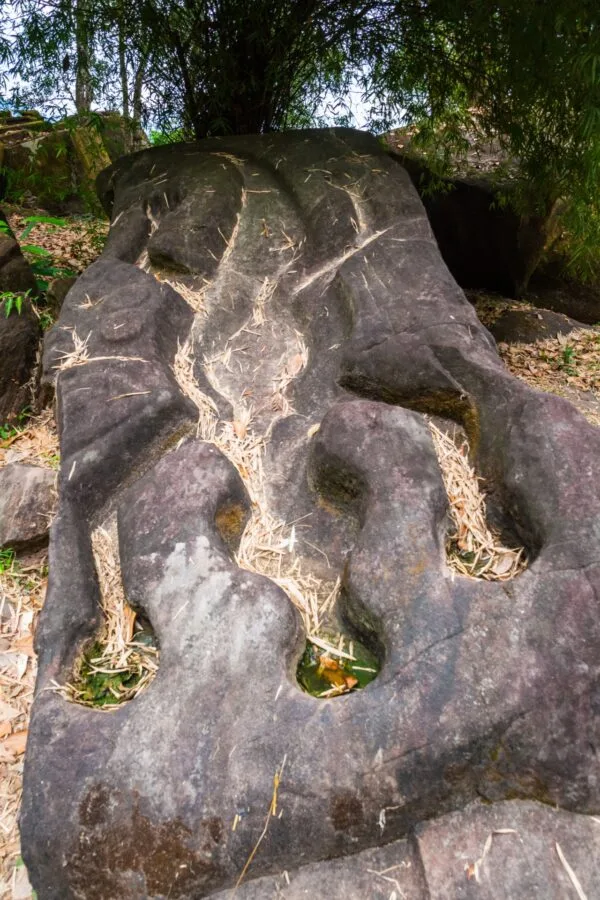
After a good while at the top, I go back down, passing a few locals who are also going up. Once at the bottom, I linger for a few moments in the north palace, to capture its roofless architecture, frozen in time.
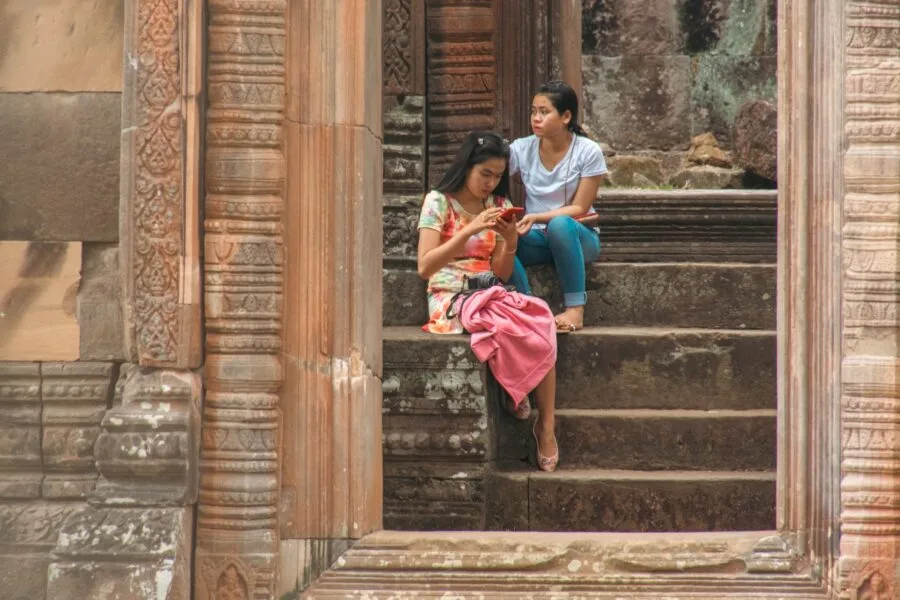
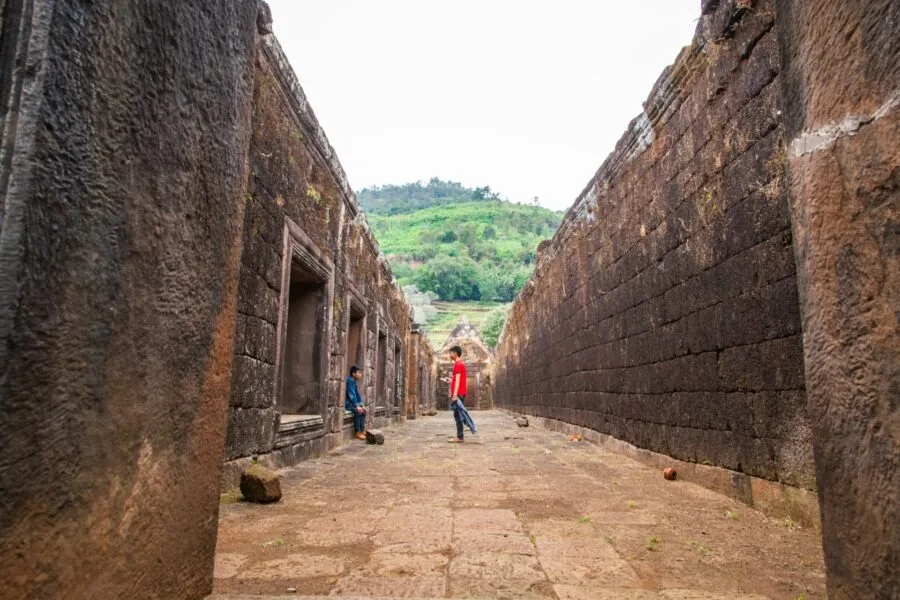

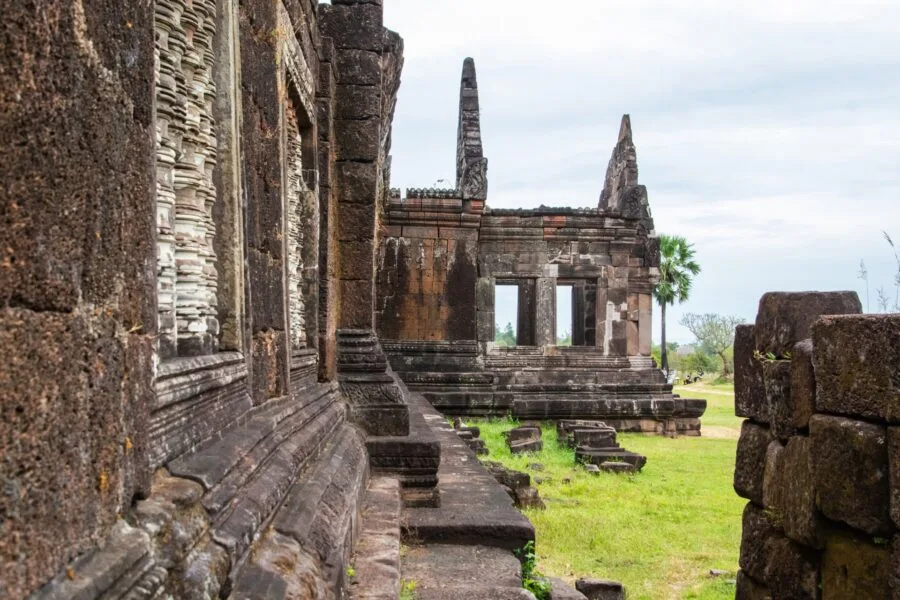

The shuttle takes me back to my starting point—a chance to take one last photo of Vat Phou, with the mountain reflected in one of the pools. I spent a little less than two hours there, without having seen the museum (built shortly after my visit).
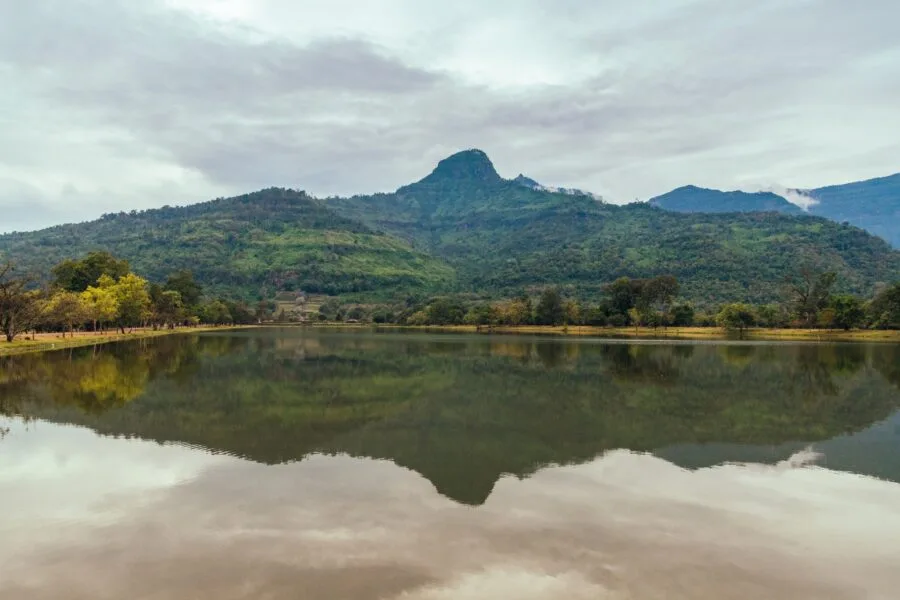
Other places of interest in the surrounding area
The weather was gloomy that day (not ideal for photos), and I wanted to visit Champasak before returning to my accommodation—my time was limited because night falls quickly at the end of the year. As a result, I didn't take the time to visit other sites around Vat Phou, but for the sake of completeness, here's what you'll find in the area:
I didn't go see Prasat Hong Nang Sida, a small ruin located 2 km south of the temple. This sanctuary has been the subject of excavations and restoration work for several years. By joining the Mekong, a little further away, you will find the Wat Muang Kang, a local temple with recently renovated old buildings.
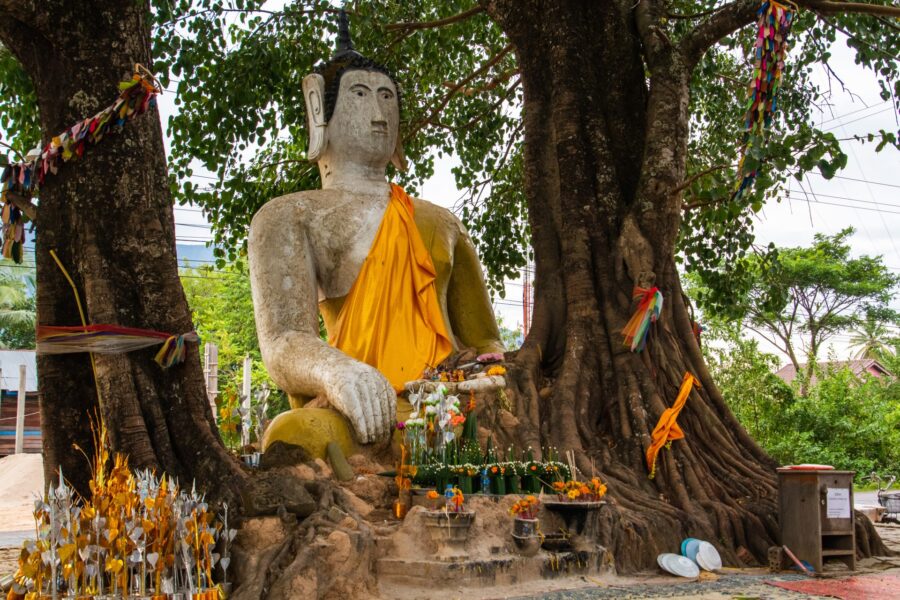
Finally, on my way back to Champassak, I stopped in front of a Buddha statue which you will find on Google Maps under the name Buddha in Wat Sisumang. Nothing exceptional, the statue dates from the 19the century, but it is framed by two bodhi trees, the roots of one of which partially buried the Buddha's legs. According to locals, it was built on an ancient Angkorian site.
Passage through the old town of Champassak
As I knew that the next day I wouldn't really have the opportunity to linger there (I had to return to Pakse not too late to catch a bus to Savannakhet), I wanted to take some photos before nightfall and return home.
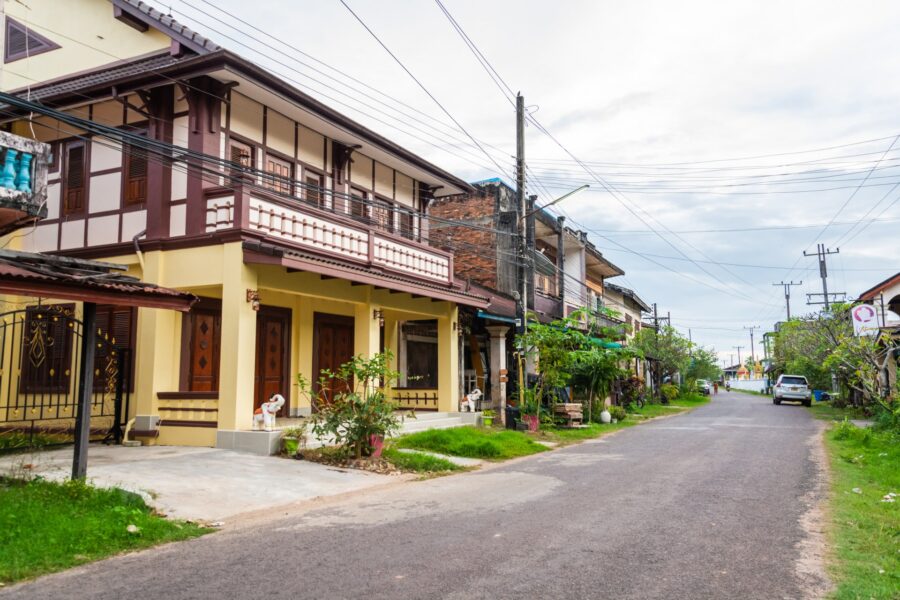
Today, Champasak (sometimes spelled with a single s) is a small, peaceful town about thirty kilometers south of Pakse, best known for its proximity to the Wat Phou site. But in the past, and I learned this while writing this article, it was much more than that: the capital of a small independent kingdom, the kingdom of Bassac, also called Kingdom of Champassak.
While walking in the main Street, which follows a north-south axis along the Mekong, it feels more like a village than a city. The houses are a mix of styles, including traditional wooden farms on stilts, but you can still see several French colonial houses (some of which are quite well preserved), as well as a few buildings linked to local royalty - such as the former residence of the last king of Champassak, Chao Ratsadanai, whose son would later become the country's Prime Minister.
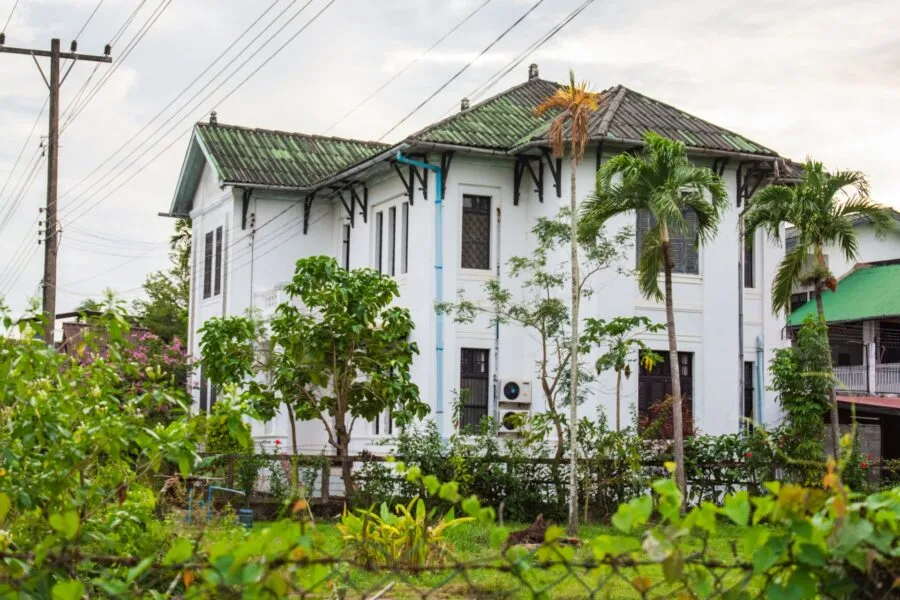
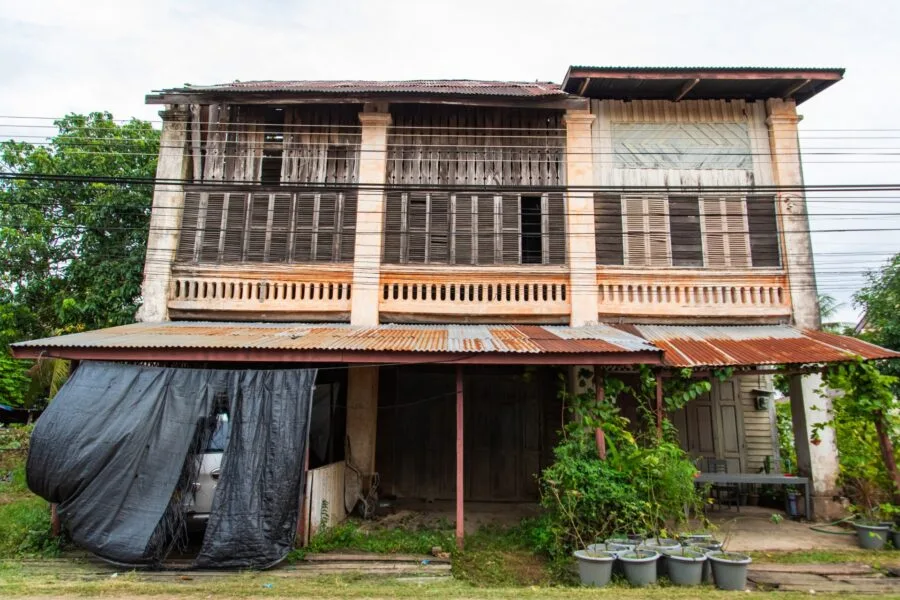


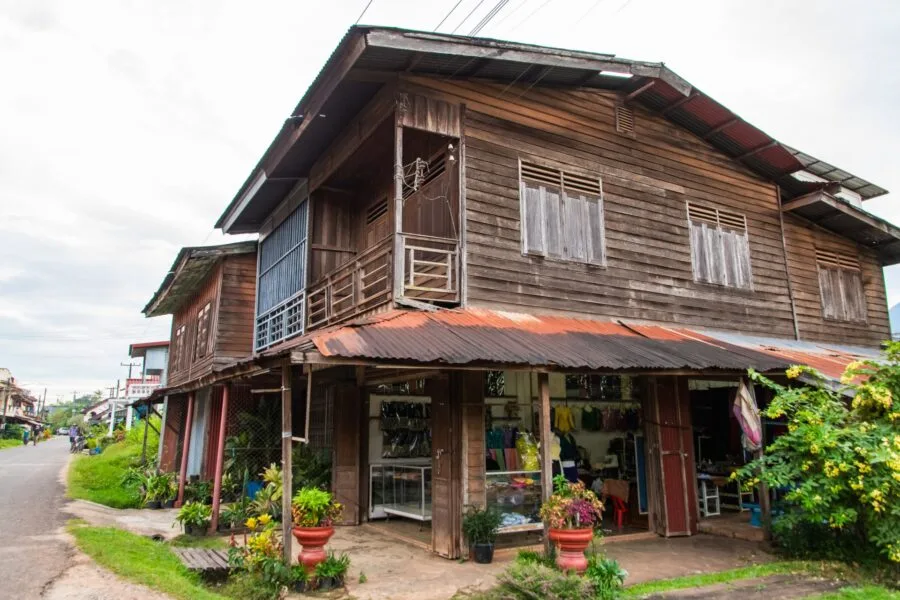
Some houses are a little abandoned but many are very well maintained and converted into hotels, cafes or restaurants, often with quite a bit of charm, like the superb Bassac Residence. It is also in this area that you will find the entertainment - all in all relative - to eat in the evening if you are staying nearby. I was just testing the Homemade Riverside Restaurant, located practically opposite the Résidence Bassac, perfect for eating in peace by the river.
Day 2 – Don Daeng, Wat Tomo and Tad Koy Loy
For this second day, I thought it would be more interesting to return via the other bank, so as not to repeat the exact same route as on the way there. I had spotted a small local boat service to cross the Mekong, which was rather convenient.
A little clarification, just to be transparent: what I'm saying here is actually a gathering of two different comings, spaced two years apart. During my first visit, I had followed the program of the day before, but the next day I had simply crossed the river to go and see the little-known waterfall of Tad Koy Loy, a little set back, but perfect for a refreshing break before returning to Paksé.
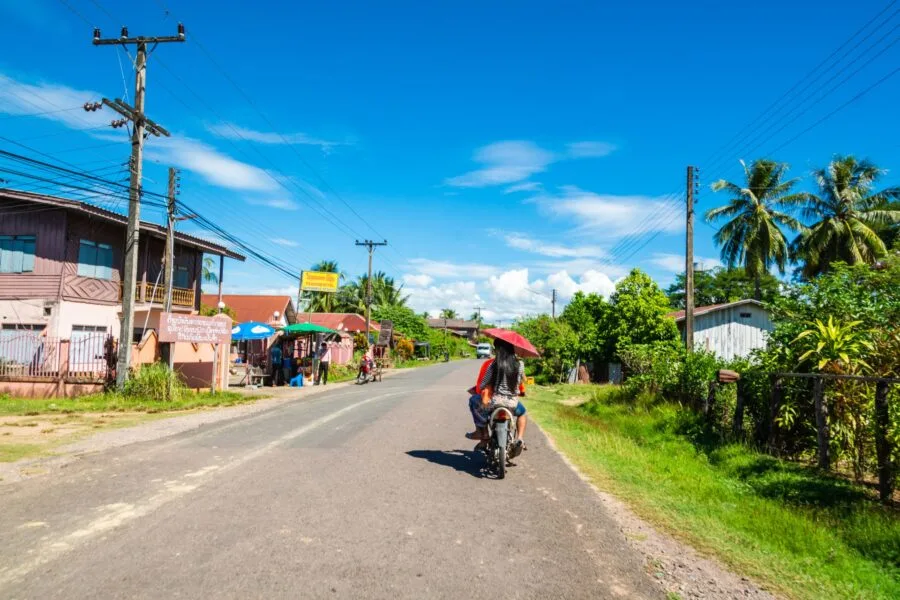
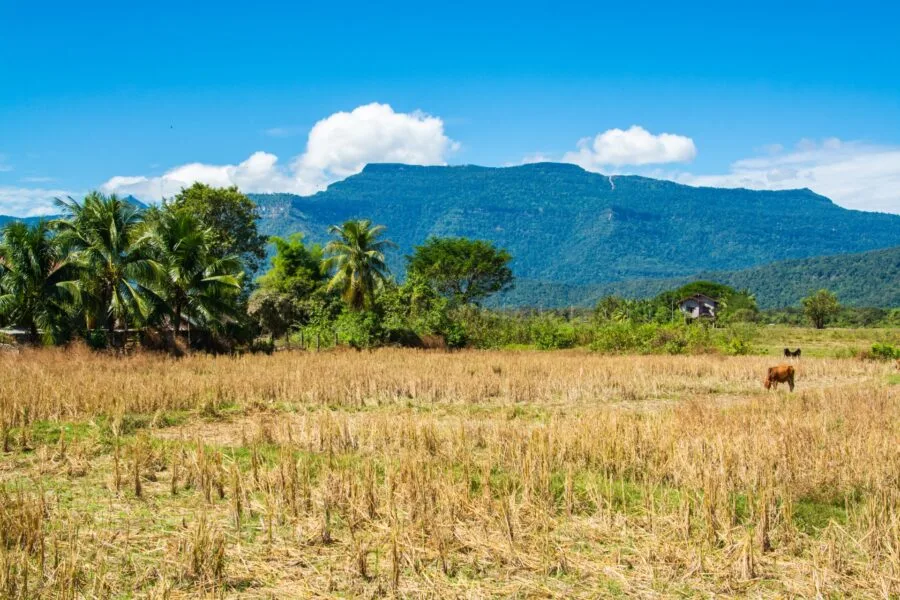
It is when returning to the region two years later, at the end of a road trip on the Bolovens plateau, which I took the time to discover Don Daeng Island and to visit the Wat Tomo, near.
Explore the peaceful island of Don Daeng
I suggest we continue the adventure. Heading for Don daeng, a large island about 10 km long lying in the middle of the Mekong River. Its name simply means “red island,” with a sign on site explaining its origins through a local legend. From what I understand, it is included in the UNESCO protected area due to its proximity to Wat Phu.
Since the island is only accessible by boat, you won't encounter any cars. If you're following this entire loop independently, you should, like me, already have a scooter or motorbike. But if you're planning a day trip from Champassak, you'll need to rent bikes to fully enjoy it.
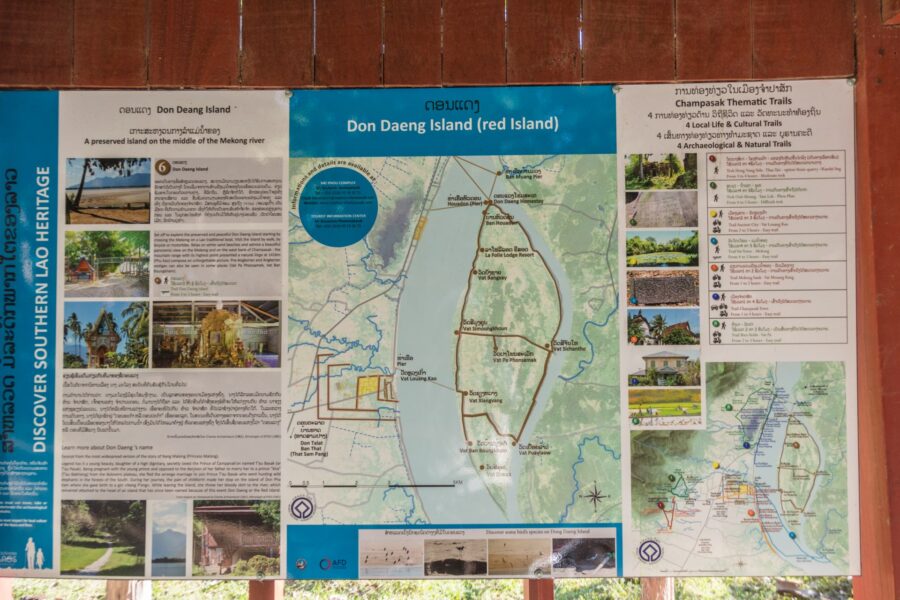
In the latter case, it seems possible to rent one from one of the hotels on the island, in particular La Folie Lodge (if they drop you off there; they lend them for free if you stay there), or else via your guesthouse in Champassak — some offer them.
My crossing of the Mekong
For the sake of consistency in the story, I will recount the visit as I experienced it at the time. And since I was coming from Attapeu, I arrived at Don Daeng after the visit to the Wat Tomo, coming from the east bank, but further south than Ban Muang.
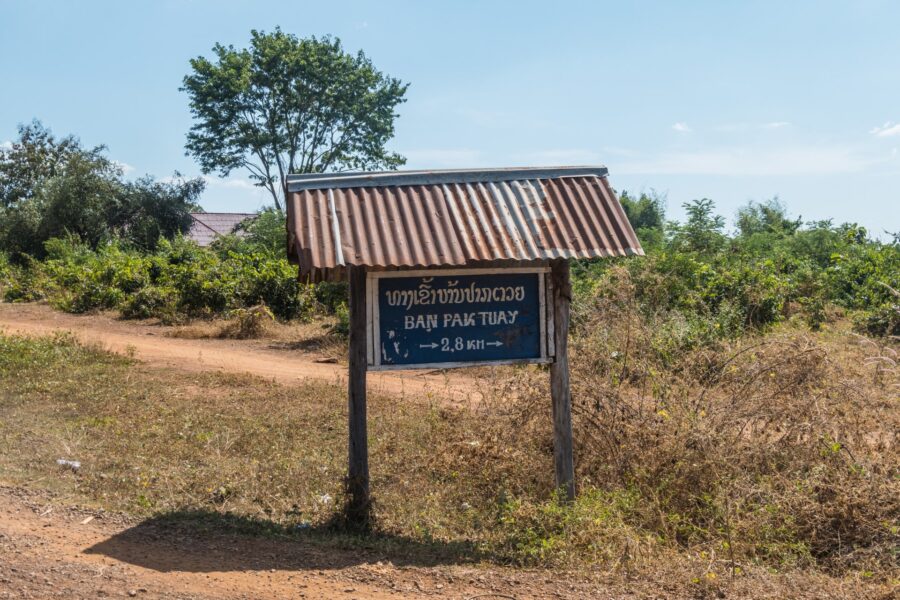
I had spotted the locality of Ban Pak Tuay, from where it seemed possible to reach the village located just opposite, where the Vat Puaylaow. When we arrived, it was quite confusing: no official signs, no marked platforms...
But after asking a local, I finally found someone with a boat ready to take me across. And good news: with a few planks placed between two boats, there was plenty of room to fit my little motorcycle.
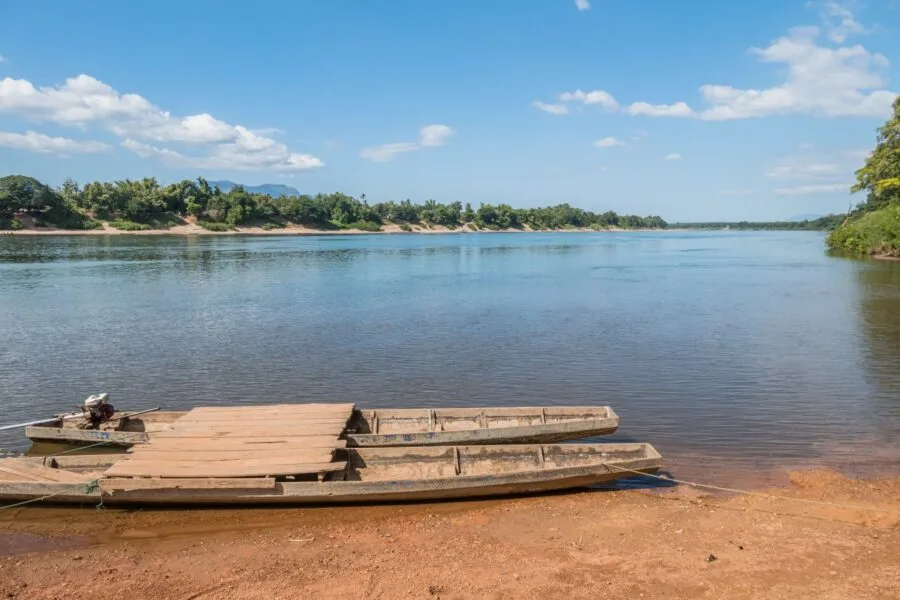
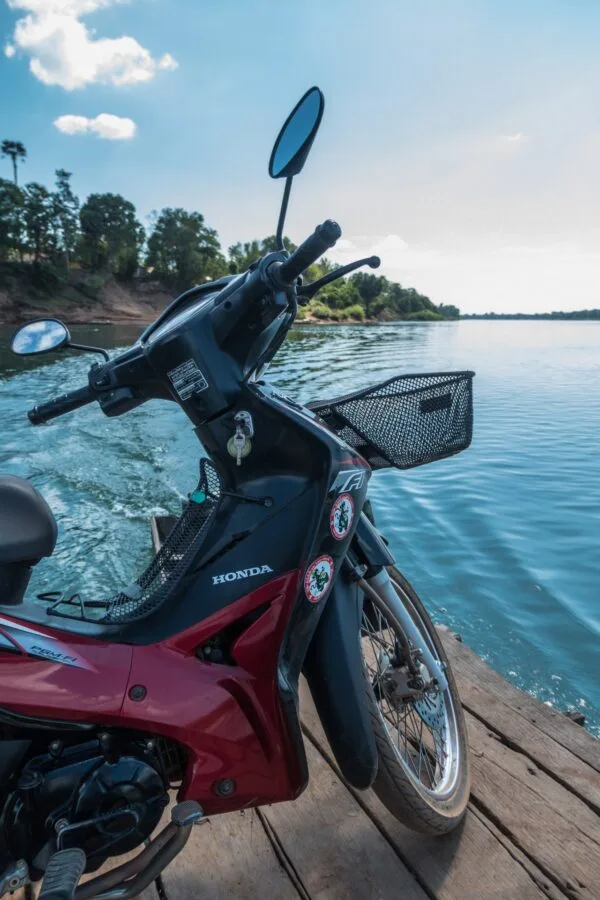
First steps
In less than ten minutes, I was on the other side, disembarked in the heart of the island. All I had to do was follow the path that crosses it from east to west to reach the other bank, where most of the villages are located.
The island is punctuated by the life of these villages—each one seems to have its own temple. We can therefore deduce that there are at least 7 or 8 of them spread across this stretch of land.
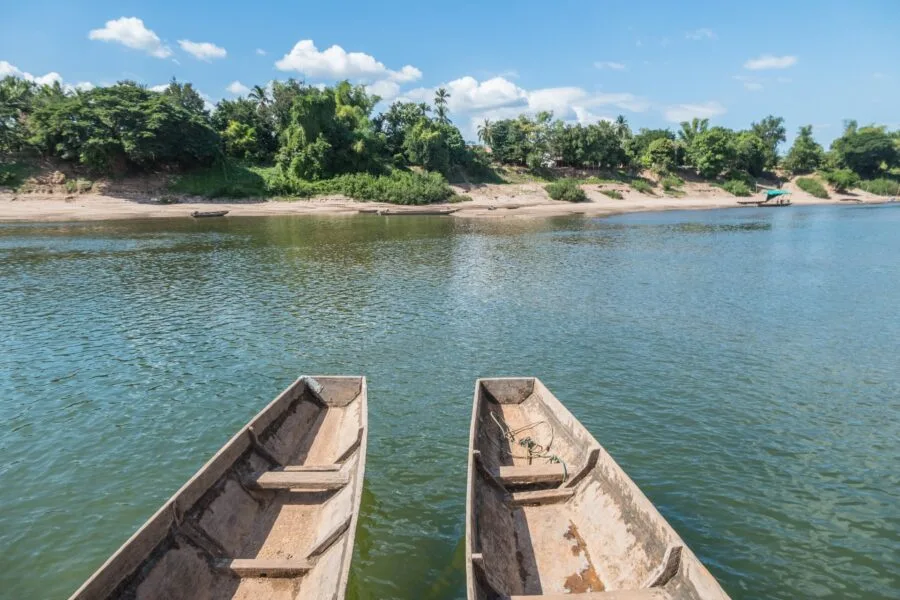
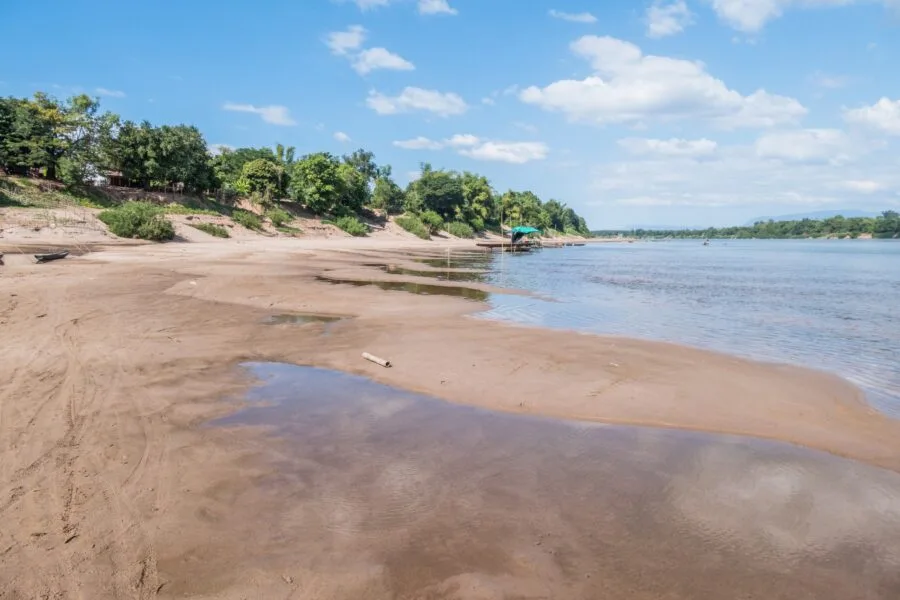
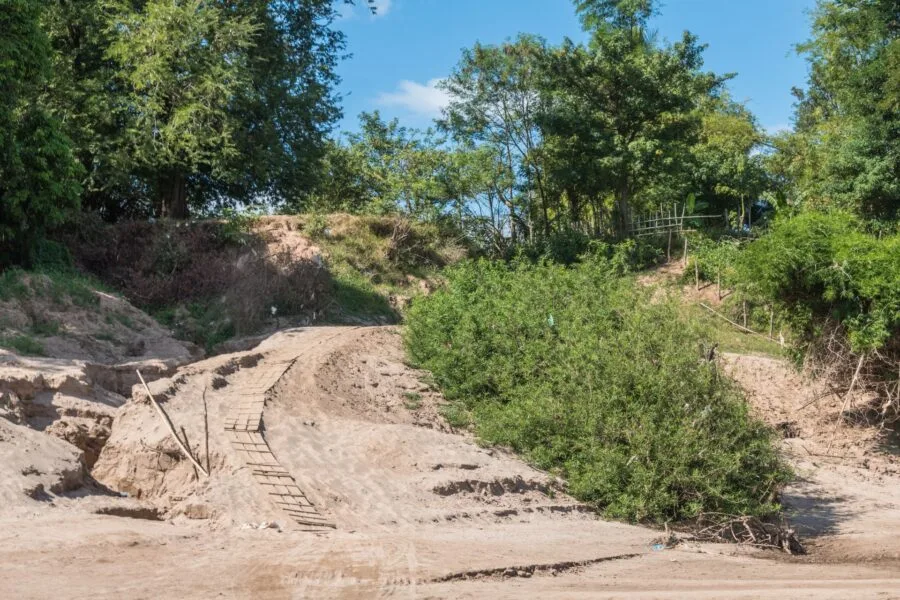
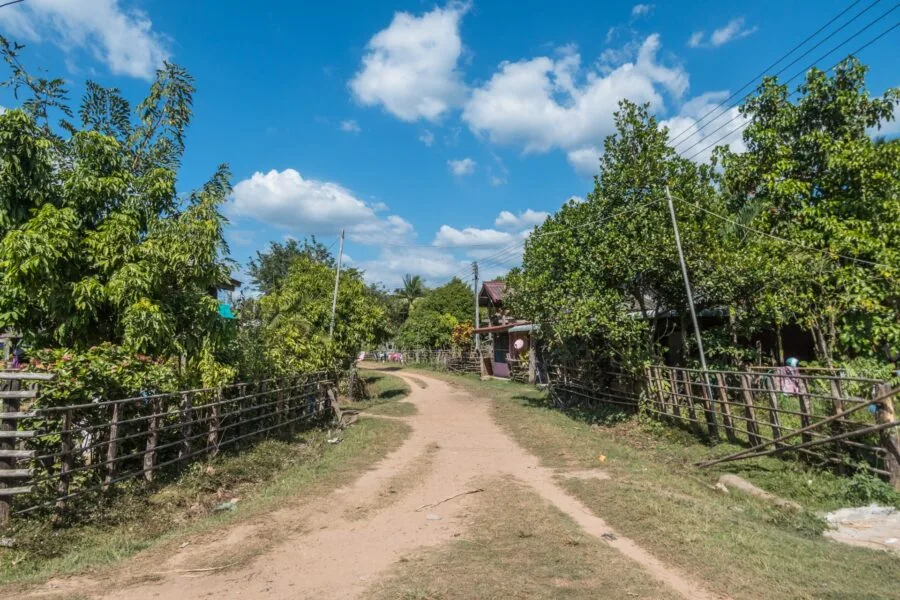
Please note: the paths are sometimes sandy or uneven, it is better to be comfortable on two wheels.
This is particularly the case in this transverse zone: the first few meters take me through an agricultural sector dedicated to rice cultivation, unfortunately empty when I came (out of season).
Visit a local temple: Vat Pa Phonsamek
After a little over 1,5 km, I arrive in a wooded area. A sign points me to a small local temple: Vat Pa Phonsamek.
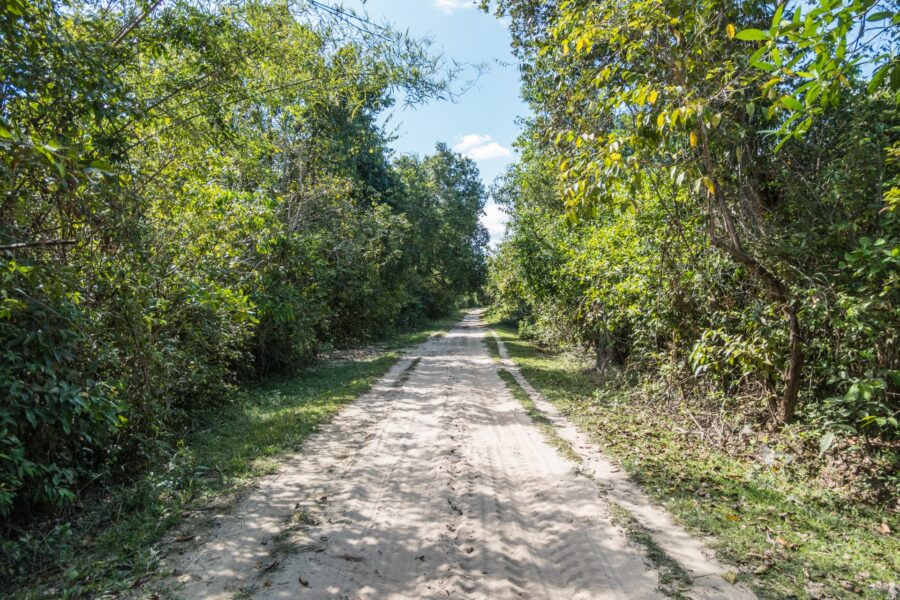
I'm starting to get hungry at this point, but while I'm passing by, I might as well take a look. From the main path, I turn left, following the sign, and head 300 meters into the forest. I come to a small, open clearing, surrounded by small chedis, or pillars, scattered around the temple—I assume these were structures used to house funerary urns.
Immediate observation : I'm alone, the place is completely deserted. The temple consists of a few posts supporting a roof, with a single wall at the back. It houses a pillar topped with a lotus flower bud, as well as the remains of an old chedi. Lacking information on site, I can't say how old it is...
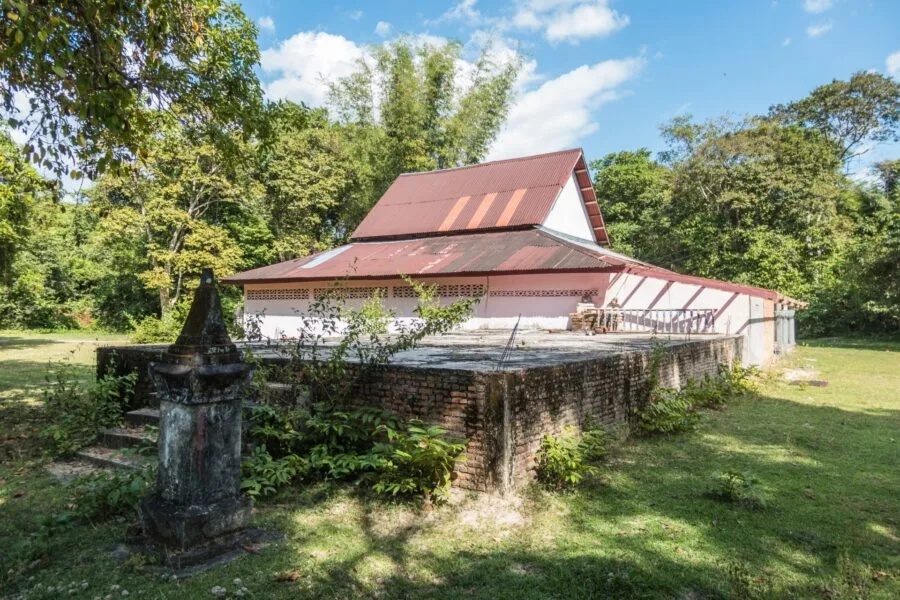

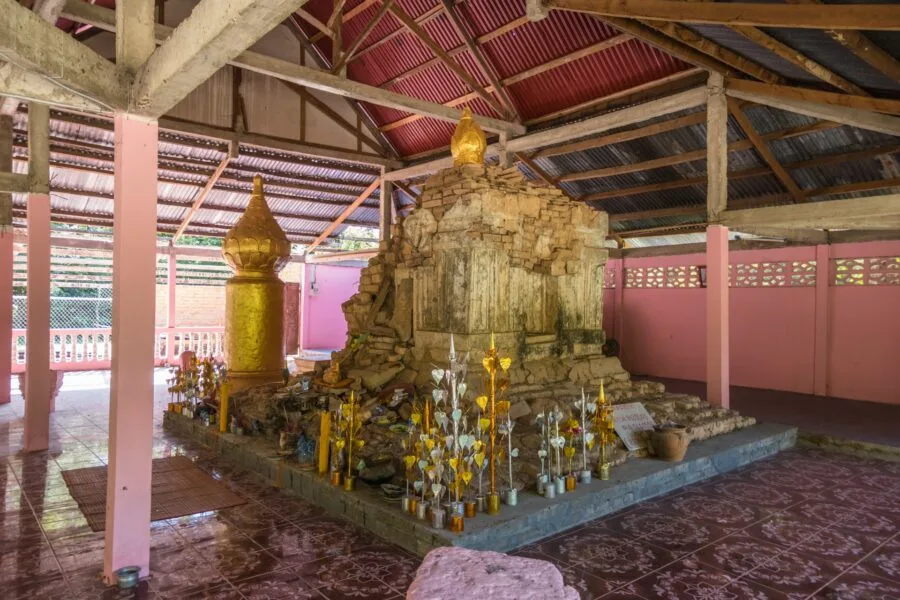
Villages, temples and a beach
Leaving the temple, I arrive a few minutes later on the other side of the island. There I pass my first houses, but also the first inhabitants, like the young people on bicycles leaving school, who watch me pass by with a curious eye.
On this part of Don Daeng, fields separate me from the view of the Mekong, while we see the mountain of Bassac in the background, we quickly forget that we are on an island. Shortly after, I pass in front of one of the small active temples of the island, the Wat Bangxai, where I stop to take two or three photos.
Just opposite, I find a path leading to a large sandbar that literally forms a beach. It really makes for a rather unrealistic landscape. A beach with mountain view, who would have believed it!
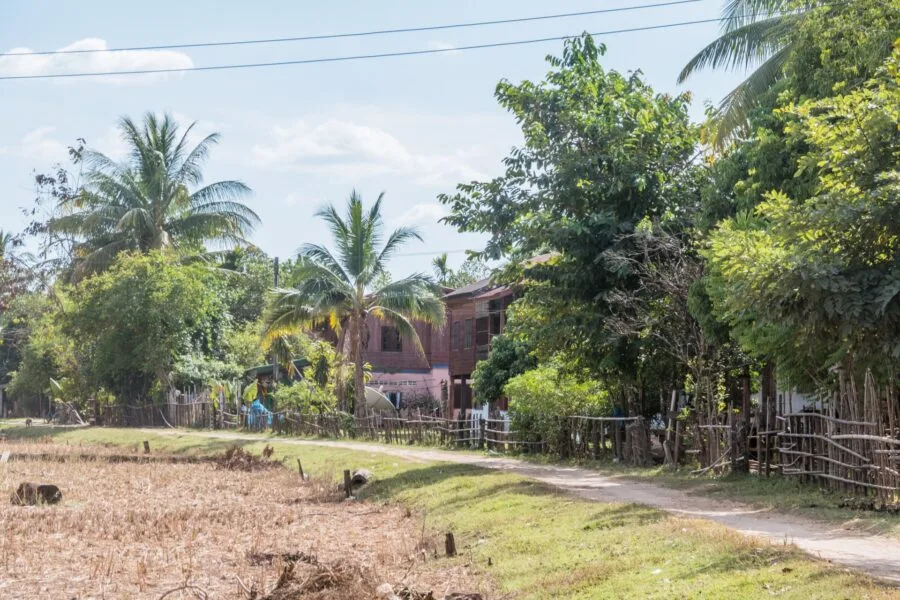
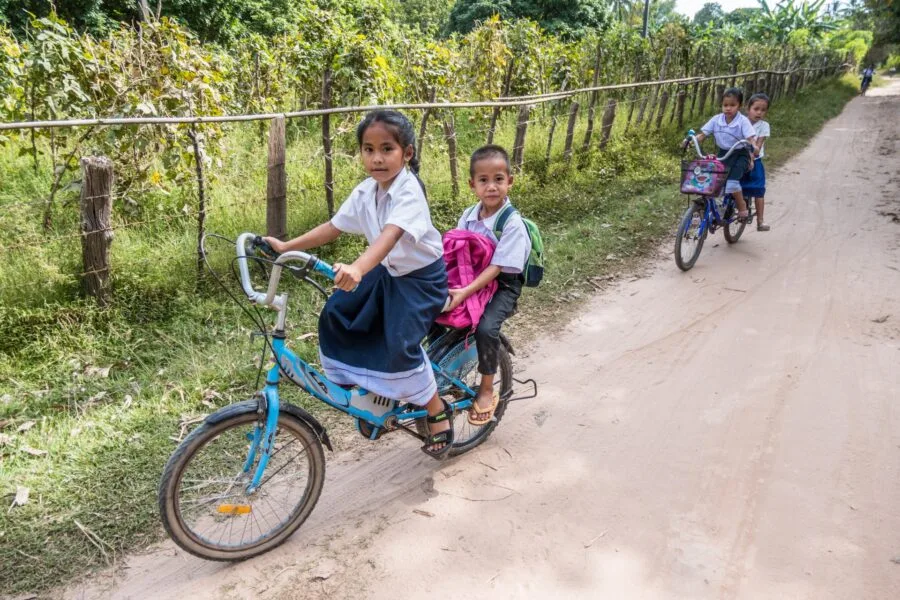
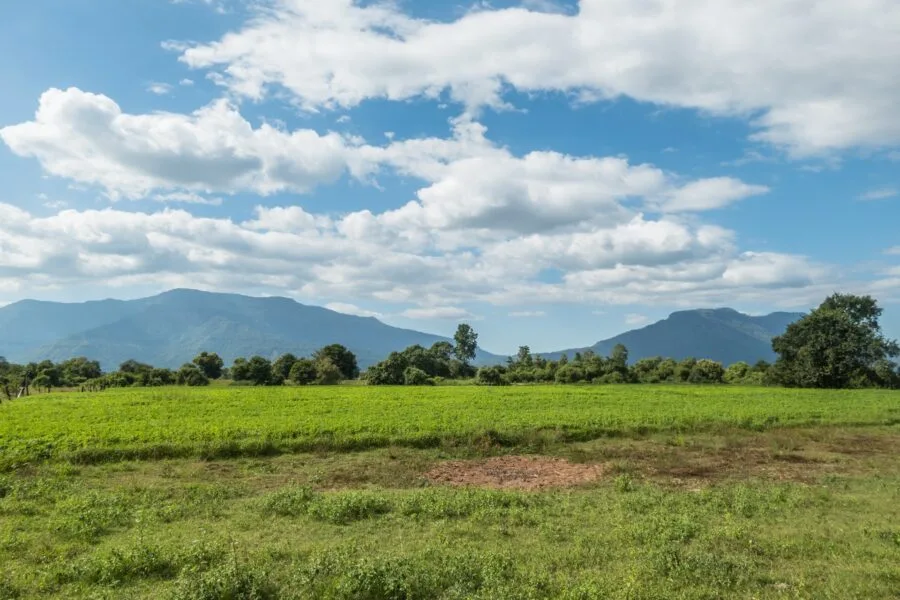
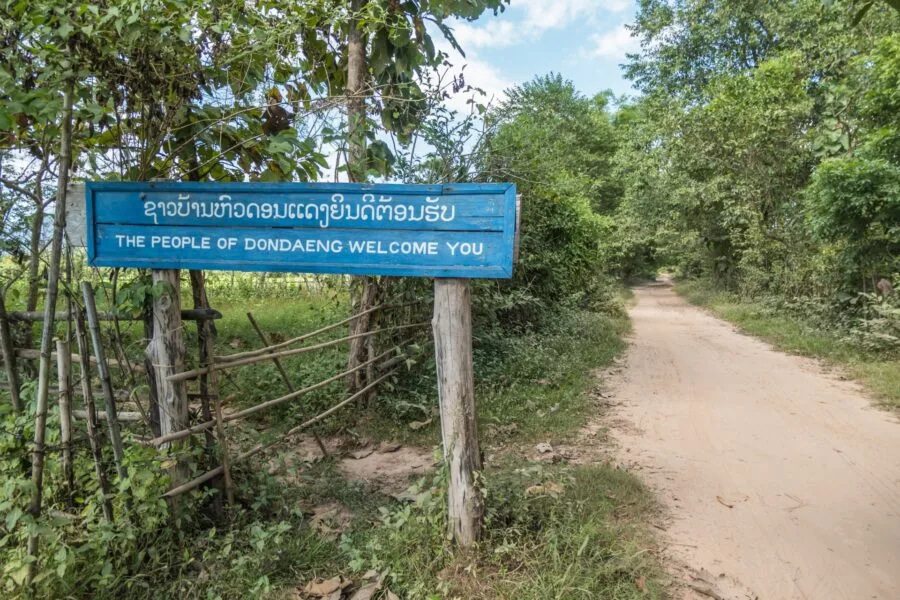

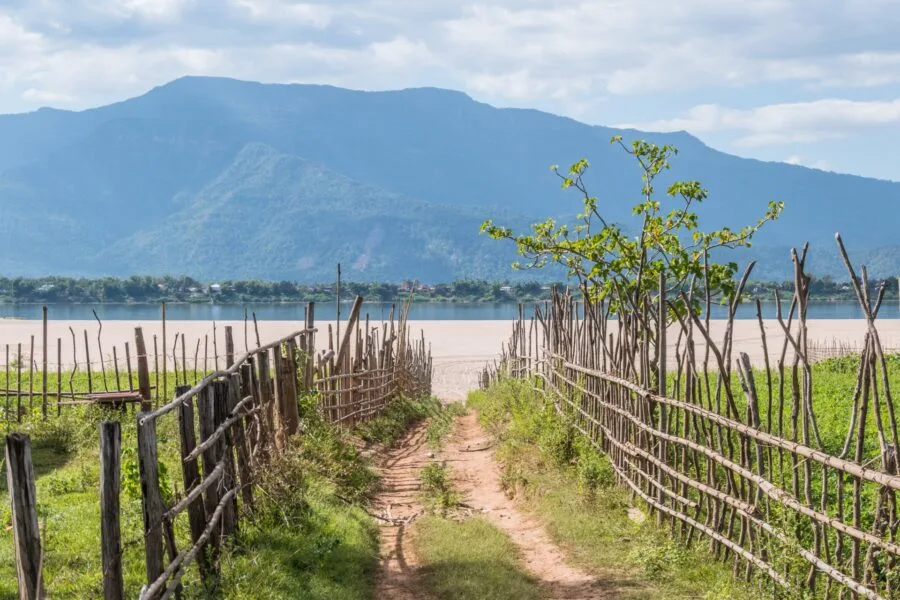
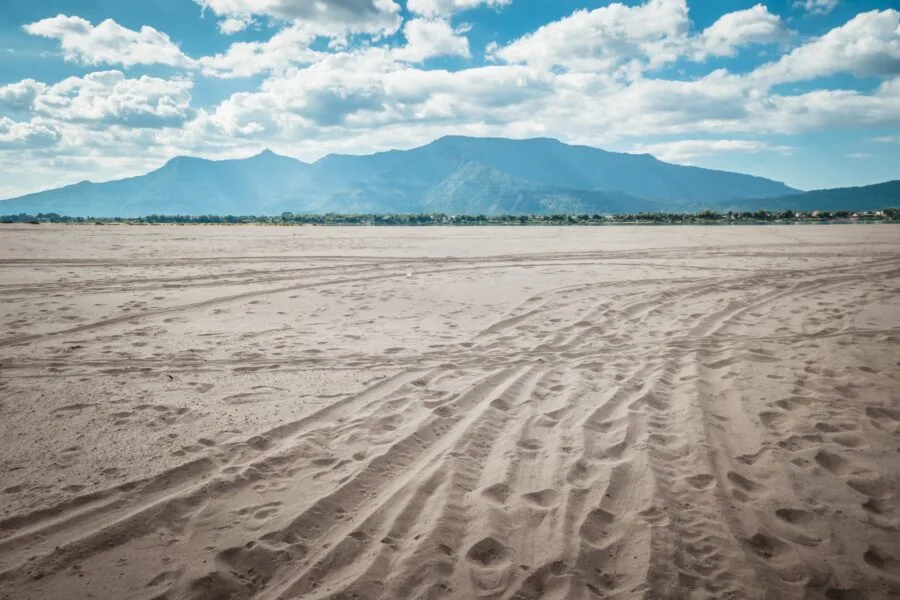
Lunch break at “La Folie Lodge”
As I said above, I was already hungry when I arrived on the island. It must also be said that before landing there, I had just completed the long trail from Sanam Xai after visiting the two waterfalls in the area (Sepa Waterfall and Sae Pong Lai Waterfall if you're interested).
Needless to say, I was exhausted and would benefit from a little rest. I had spotted the place while planning my itinerary, and it was the main reason for my visit to the island, so I had promised myself a little reward... which came in the form of a well-deserved meal: a good burger!
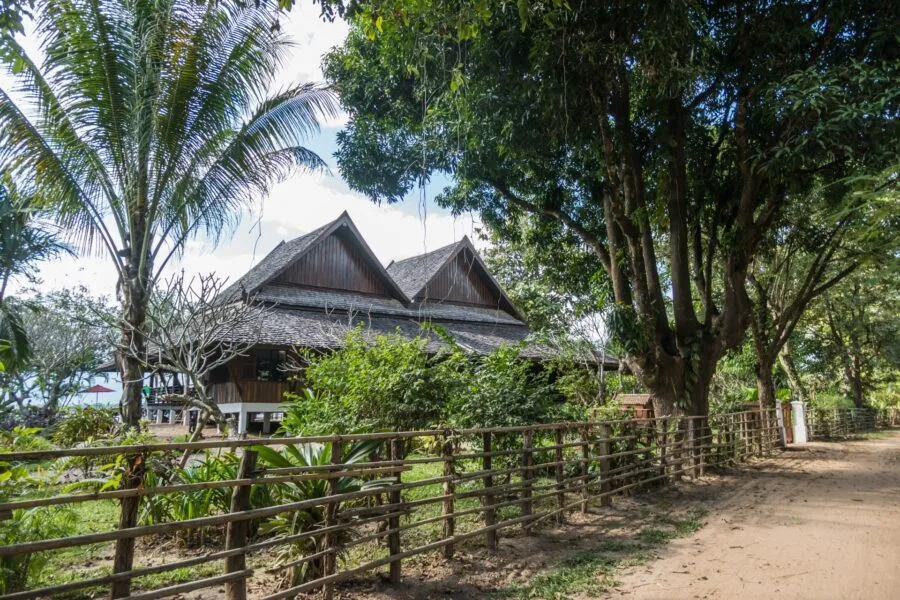

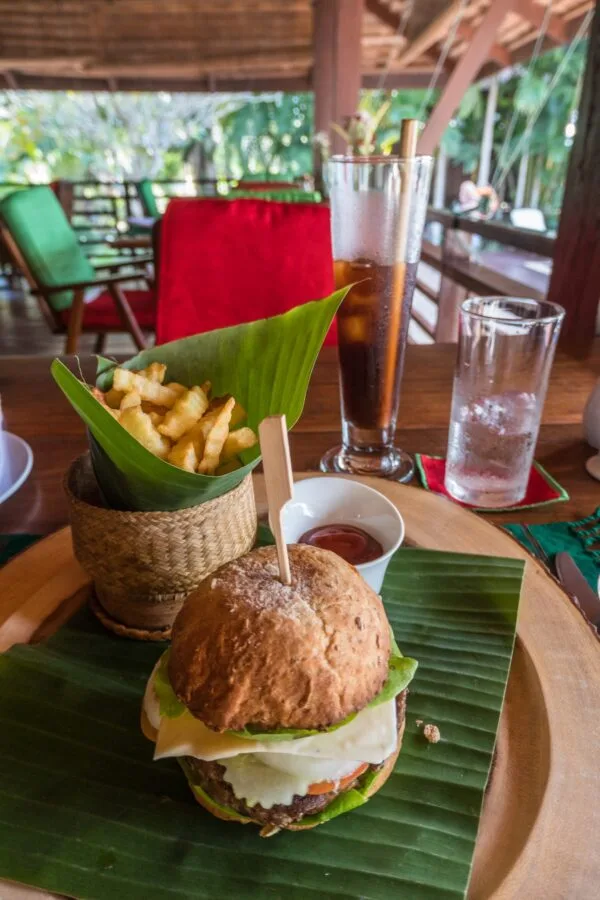
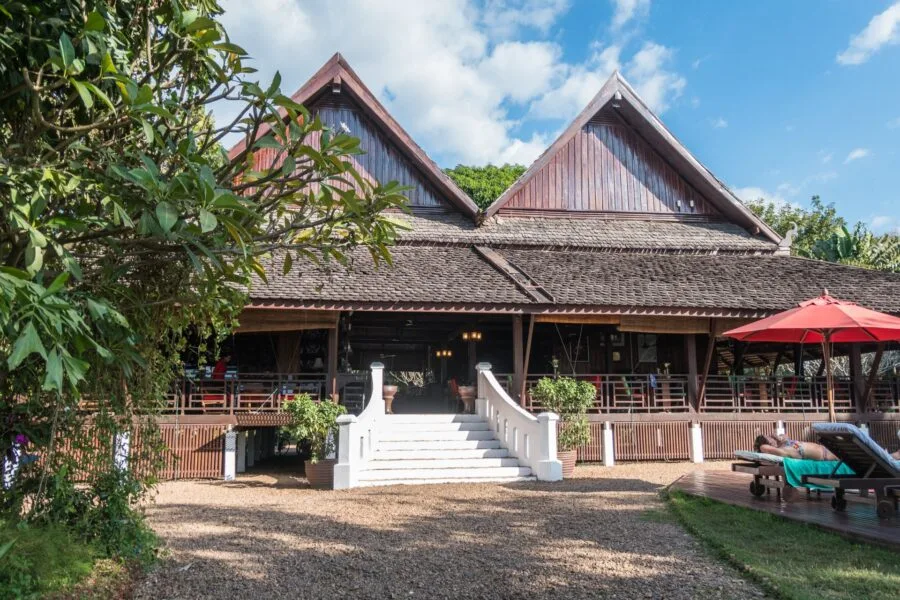

I admit that when I arrived, I was a little ashamed. After 75 km of sandy track (not counting the detour to Wat Tomo), I frankly didn't look very presentable: filthy, sweaty, and my pants covered in red dust. But no matter—in Laos, no one judges you. And despite the Folie Lodge's prestige, I was welcomed with a smile.
After my meal, I took the opportunity to take some photos of the establishment, but since I wasn't staying overnight, I didn't dare venture into their beautiful garden. However, I did walk down to the shore to take a look at their own "beach," which is visible at this time of year.

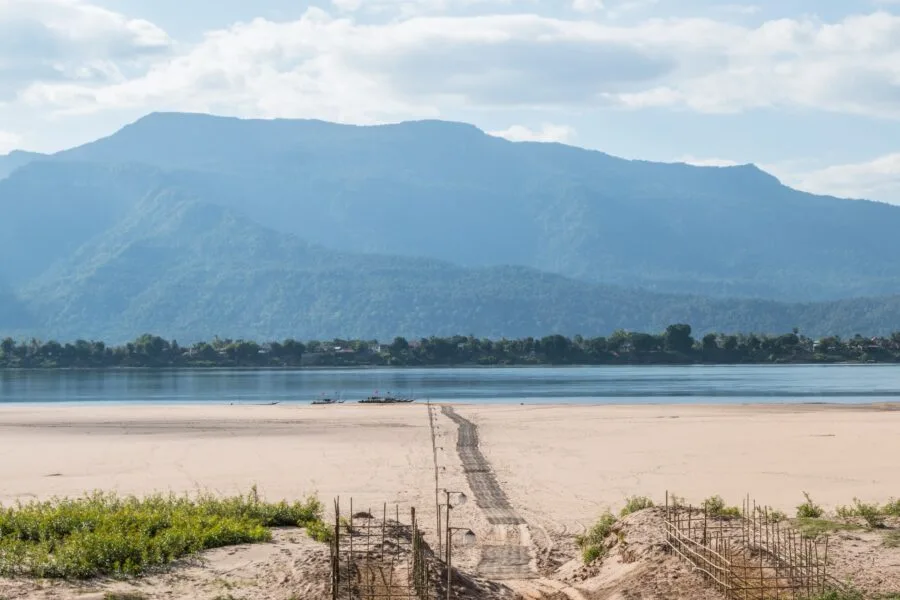
After an hour's break, I had to leave again because I couldn't afford to linger even though the afternoon was already well underway.
North point and return to dry land
La Folie Lodge is less than a kilometer from the north of the island. As a digestive stroll, I hopped on my little motorbike, as dusty as I was, to reach the point where the Mekong splits in two. I came across another temple on the island shortly after, the Wat Ban Huadone, but I don't see any activity there so I don't linger.
I reach an access point leading to the sandbar. Straw forms a makeshift path to prevent motorcycles from getting stuck, as this is the main access point to Don Daeng if you're coming from the Champassak terminals mentioned above.
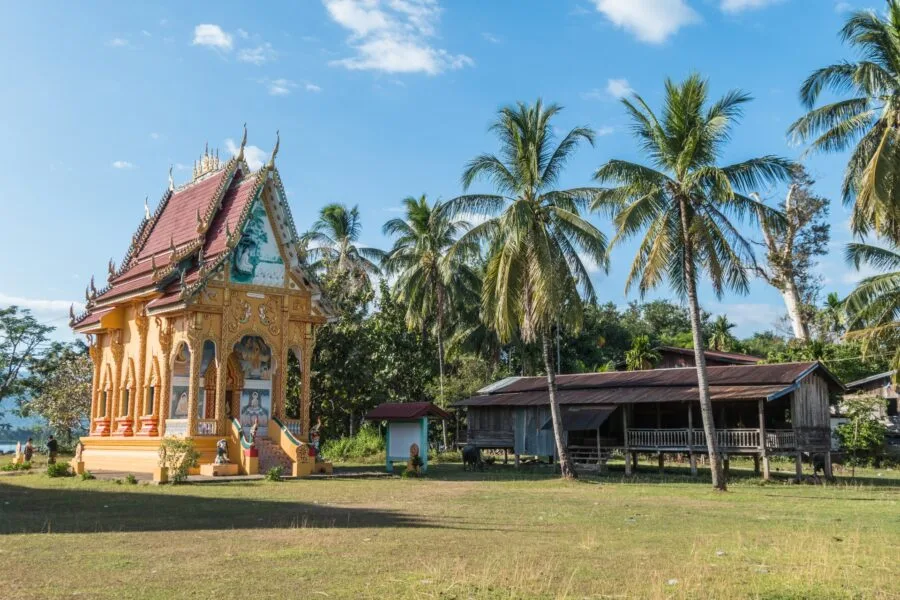
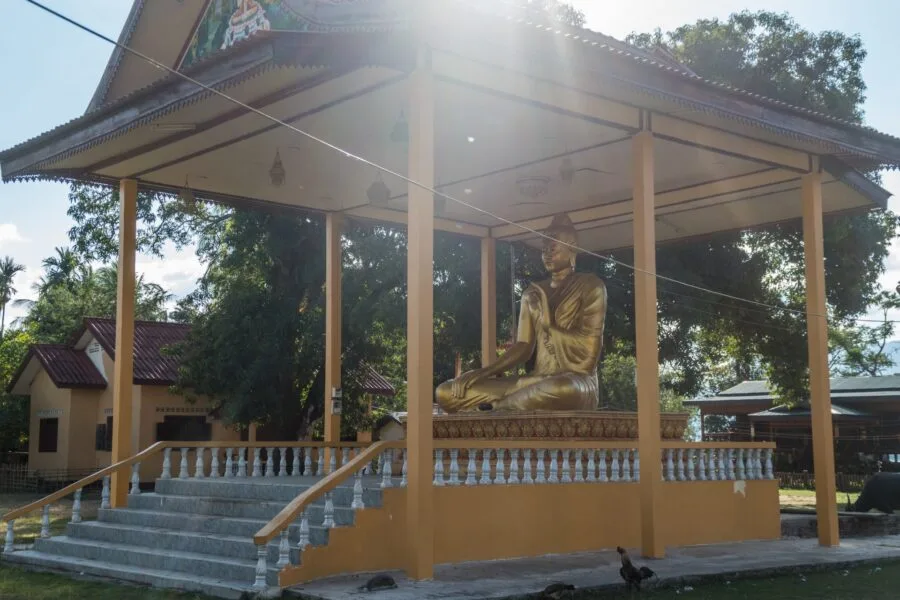
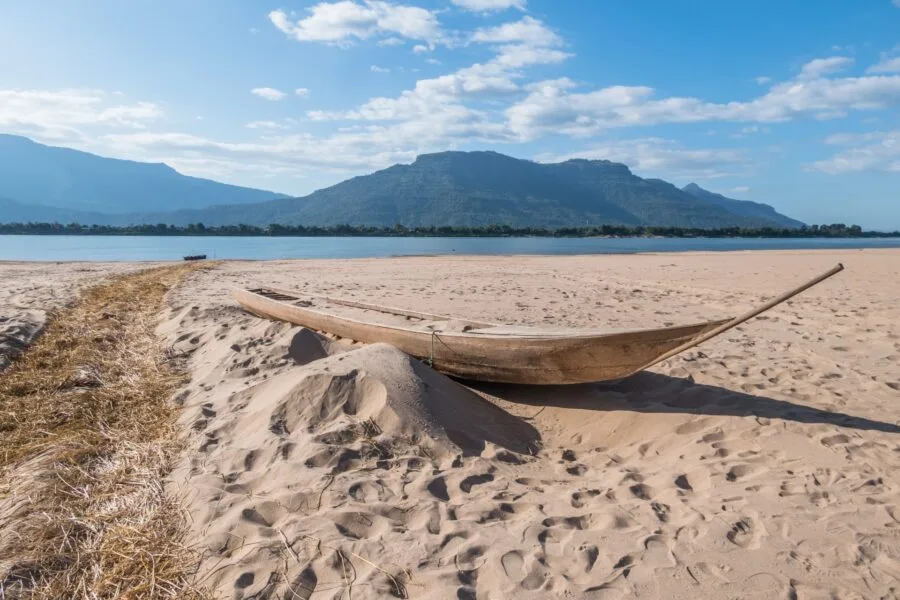

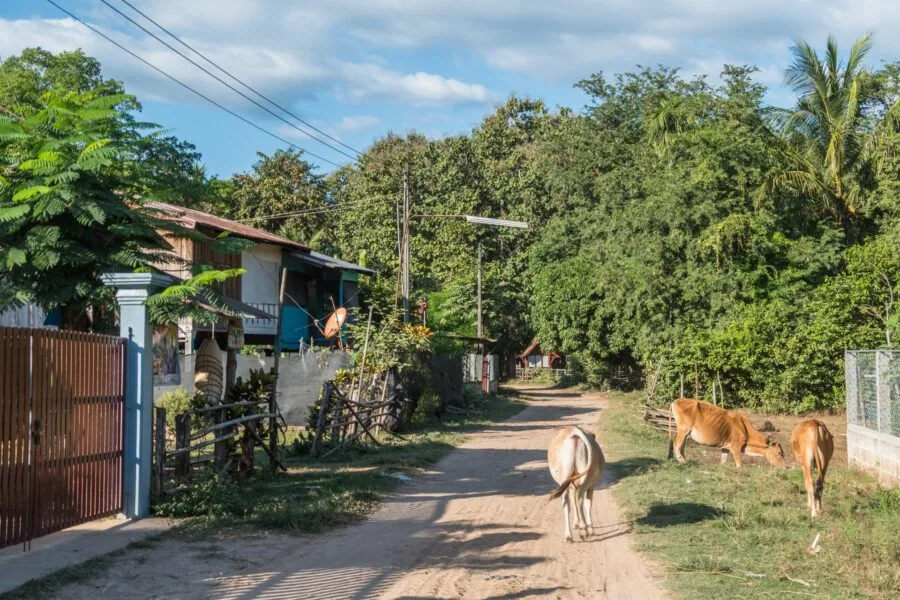
It turns out that on the day I made this visit, this was the point where I was exiting the island, rather than having to return to my entry point, since it was closer to Pakse.
As I waited for a boat to take me back to Champassak West Terminal, I saw in the distance a group of fishermen combing the area by hand (fishing for shellfish?), in the shallow water there.
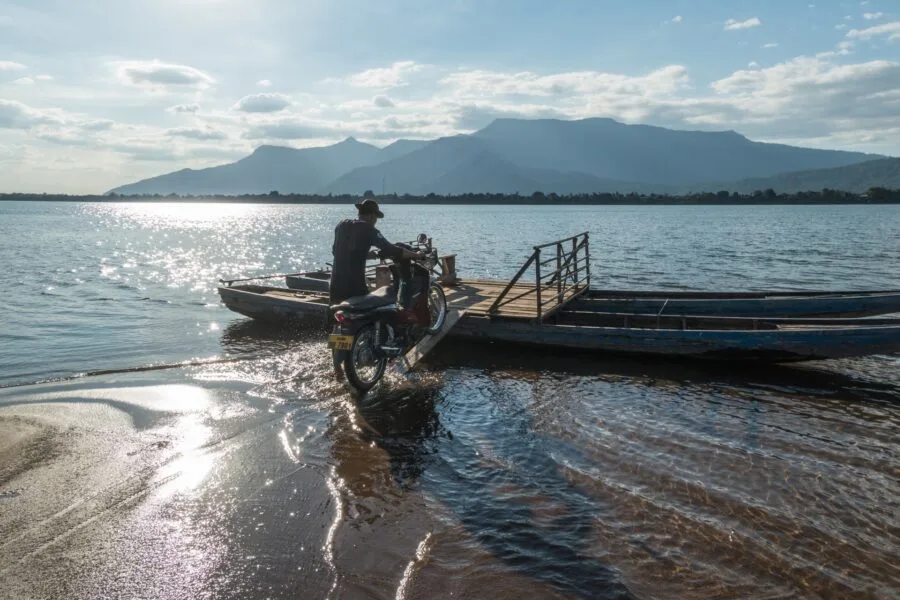

I spent barely two hours on Don Daeng, which is still very little given the size of the island. To enjoy it peacefully and do a real complete tour, it is better to count at least 3 to 4 hours, especially if you do it by bike.
A short detour to Wat Tomo
As I mentioned before, my route through the region was different from what I suggest in this article, so I'm placing the visit to Wat Tomo after Don Daeng Island, because this order seems more logical to me to complete the itinerary I'm suggesting here. Among other things, because Don Daeng is more interesting to visit and if the timing is too tight, it's clearly Wat Tomo that I would "sacrifice" first.
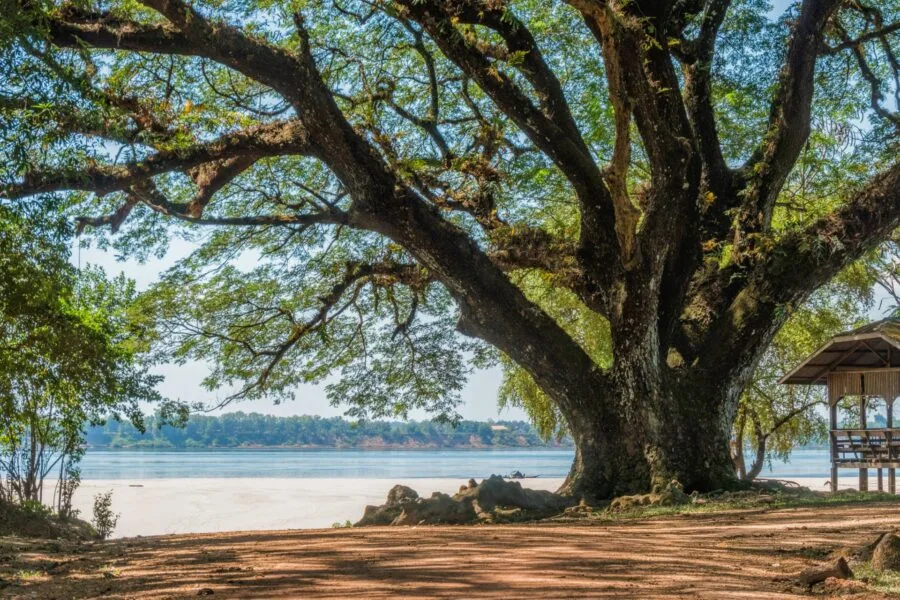
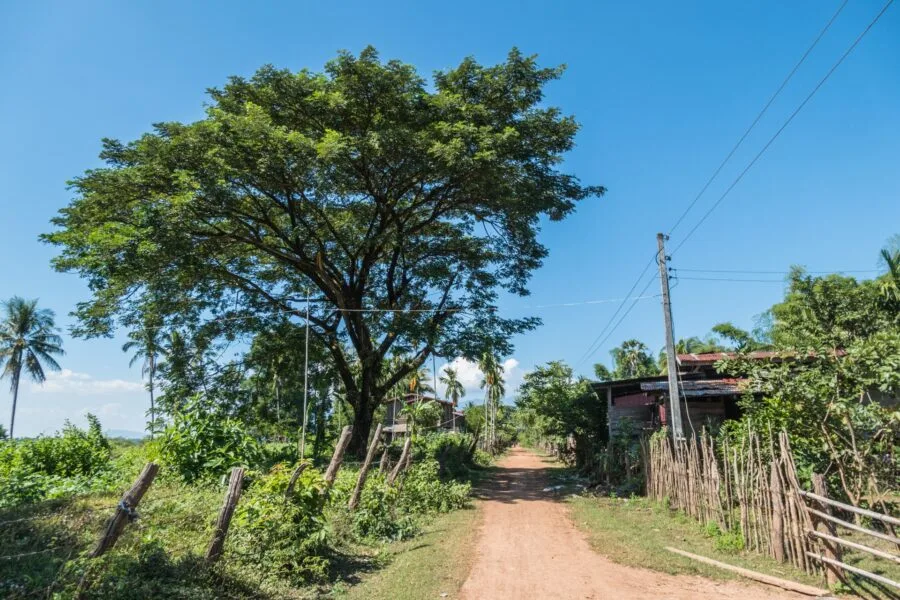
To continue, it would be logical in this case to finish the tour of the north of Don Daeng by returning via the east coast and leaving the island via the same point by which I accessed it, Pak Tuay. There are then 9 km to reach Wat Tomo, of which only 2 km are on paved road...
Wat Tomo, significantly smaller and less impressive than Vat Phou, is also much less well-known. Located away, hidden in the vegetation, this ruined temple may not have the grandeur of its neighbor "across the street", but it exudes a real mystical aura. You are surrounded by a forest of majestic trees, and the place, somewhat left untouched, offers a unique atmosphere - especially if, like me, you are there alone.
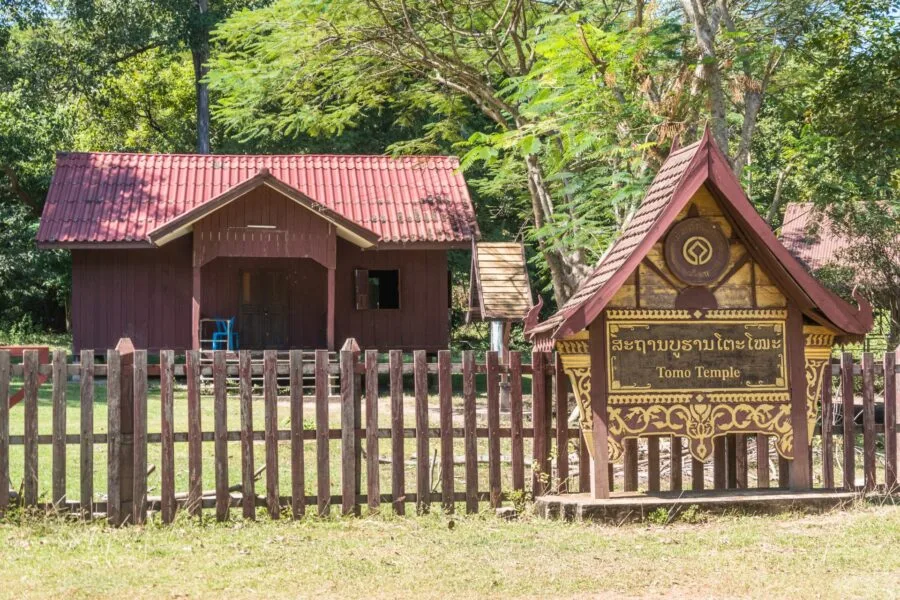

An explanatory panel at the entrance tells me that a first temple existed here at the same time as the construction of Vat Phou (between the 7e and the 9e century), and that what we see today comes from a reconstruction dated 11e or 12e century.
The main building is a rectangular structure with two lateral outgrowths. It contains a well-preserved lintel, fragments of carved nagas, a pedestal, pieces of walls... and, above all, a carpet of stones scattered throughout the forest, right next to the small Huay Tomo River, a tributary of the Mekong.
I didn't see a single person there and it's free to enter, so if you're feeling adventurous, Wat Tomo awaits!
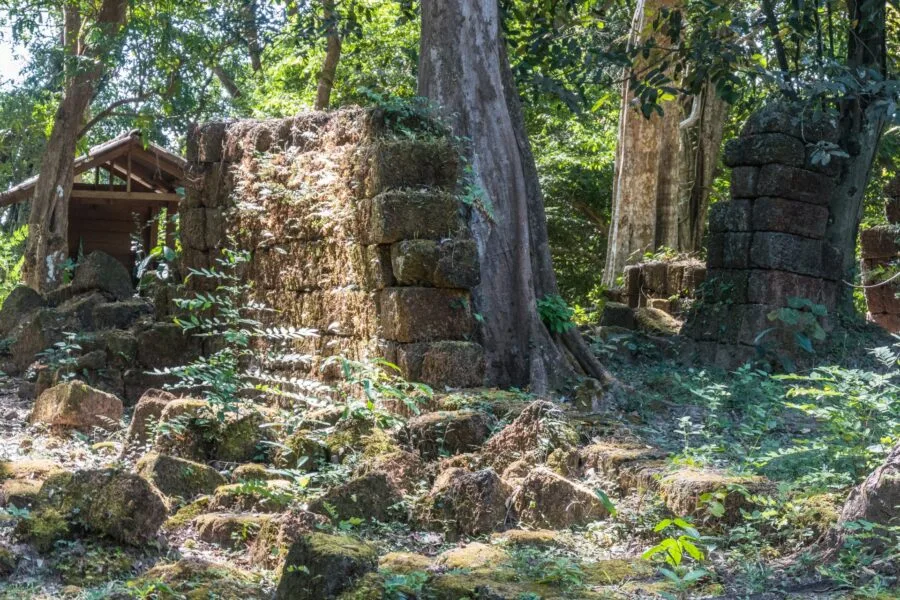

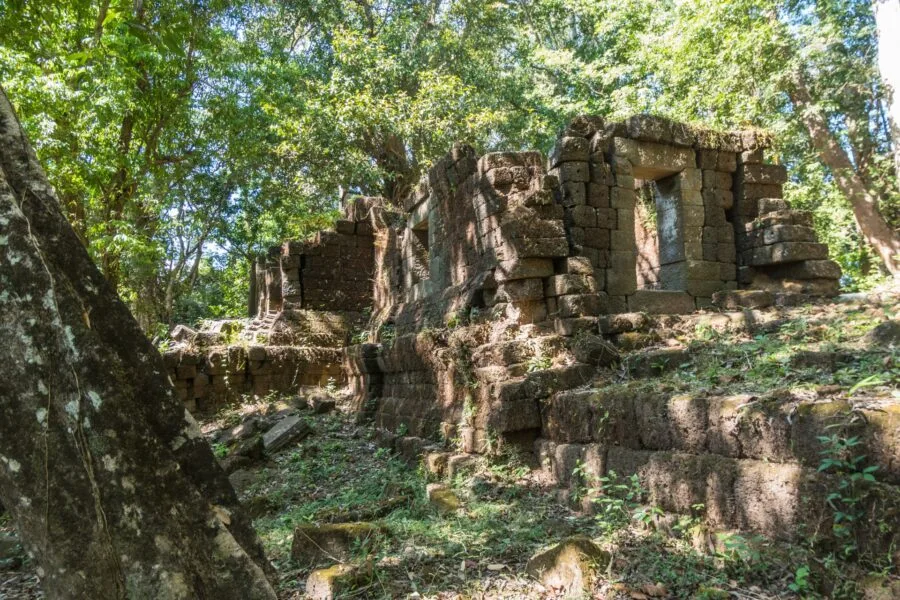
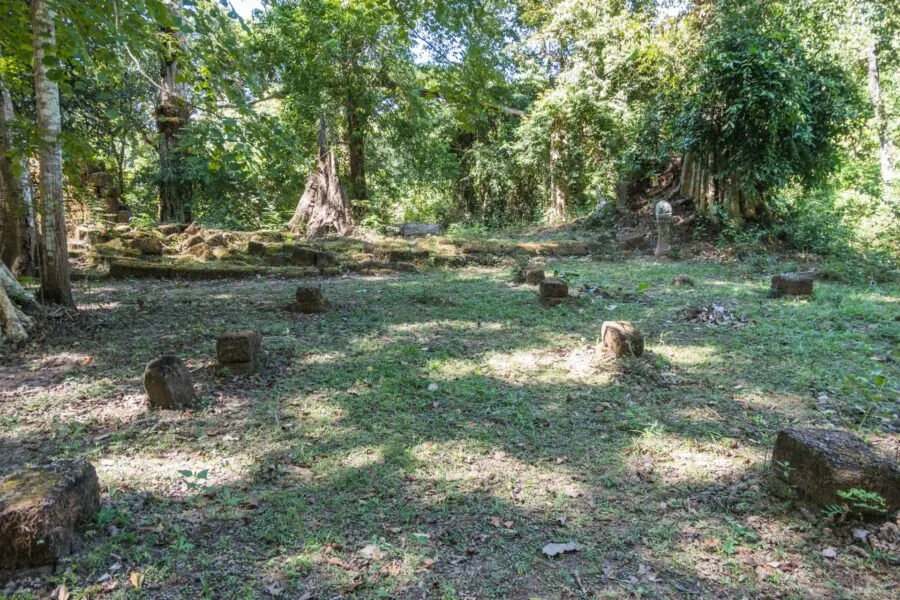

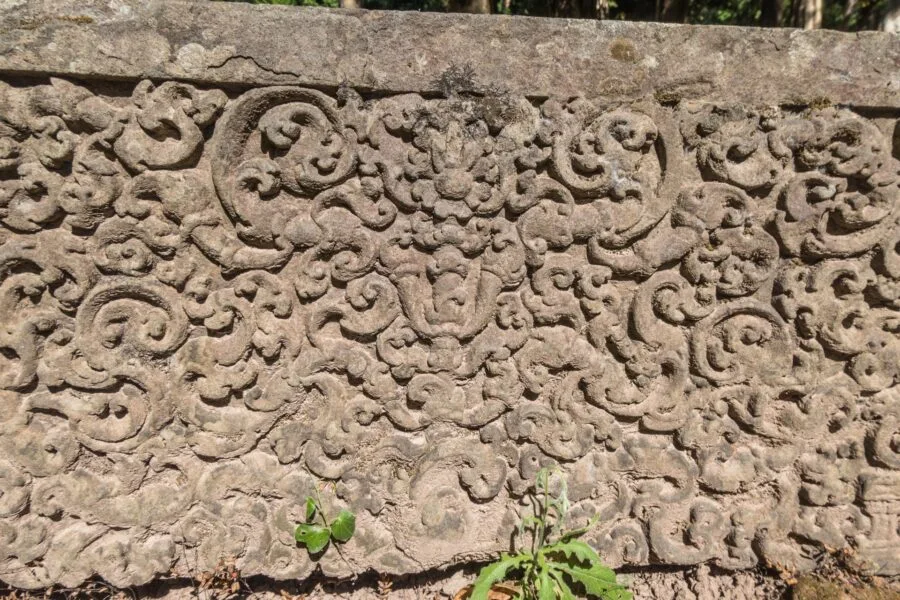

End of the loop: relaxation at the Tad Koy Loy waterfall
To provide some context, it was the day after my visit to Vat Phou and Champasak that I crossed the Mekong River to reach Pakse. But rather than driving on without visiting anything, I had spotted this small waterfall that didn't require me to make a big detour. Indeed, Tad Koy Loy Waterfall is located less than 6 km from the main road.
After Laos, it's 6 km of track... The ground, sometimes sandy, sometimes hard and bumpy, is tinted with that characteristic red, which seeps into all your clothes (avoid wearing your favorite t-shirt, you risk ruining it like a local dye lol). But overall, access remains easy at this time of year (still November). I pass kids coming out of school, some of whom give me a big smile as I pass.
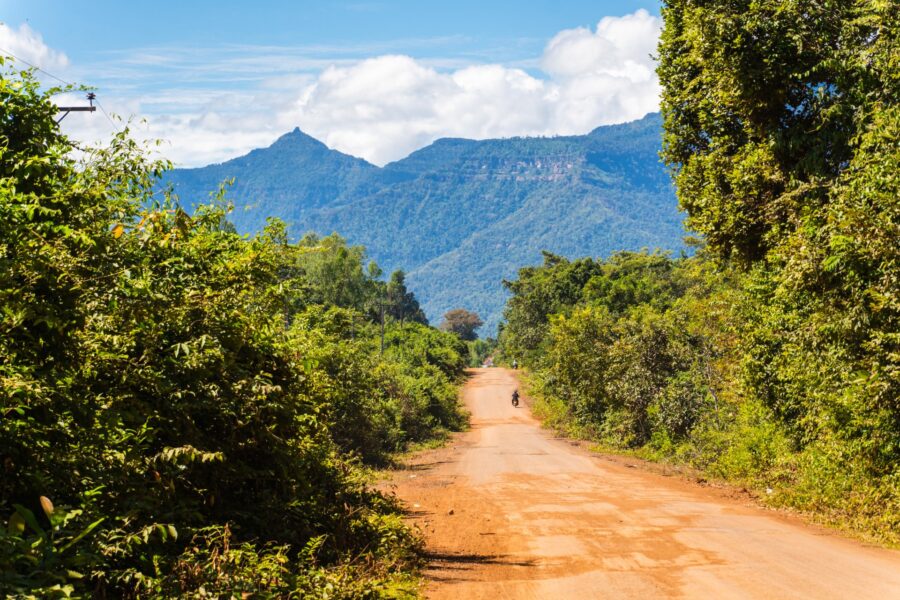
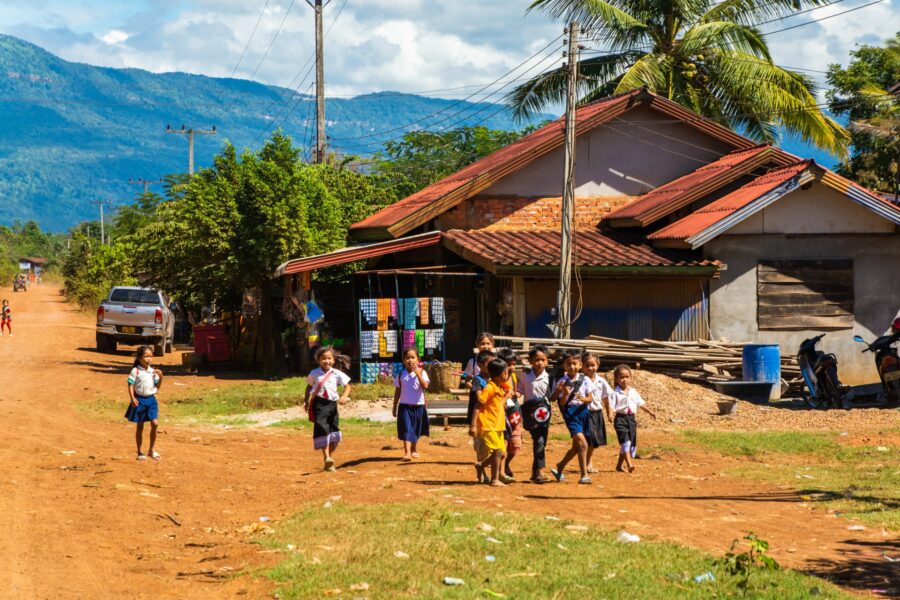
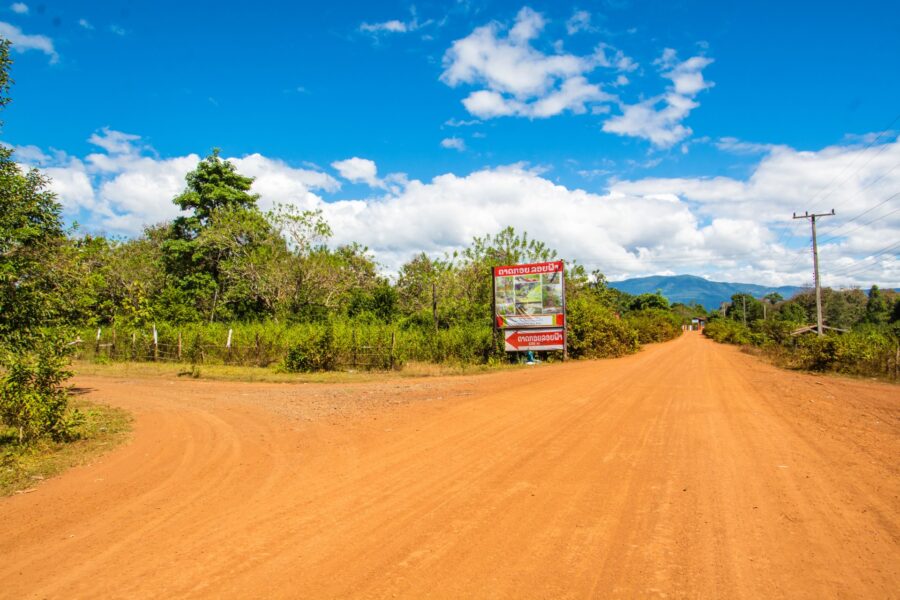
A large canvas sign clearly indicates the waterfall at a fork, even though I have 500 meters to go. When I arrive there, I see small wooden salas (a sort of straw hut on stilts) with palm leaf roofs at the water's edge—perfect for a break in the shade, and for some, with their feet in the river.
The waterfall itself isn't very big, but the water is beautiful, and it's surrounded by forest, providing a pleasant setting for relaxing. Some families are also there to picnic and enjoy this natural site that encourages relaxation. I personally won't enjoy it any further because after 20 minutes there, I already had to leave to catch my bus to Savannakhet in Pakse.

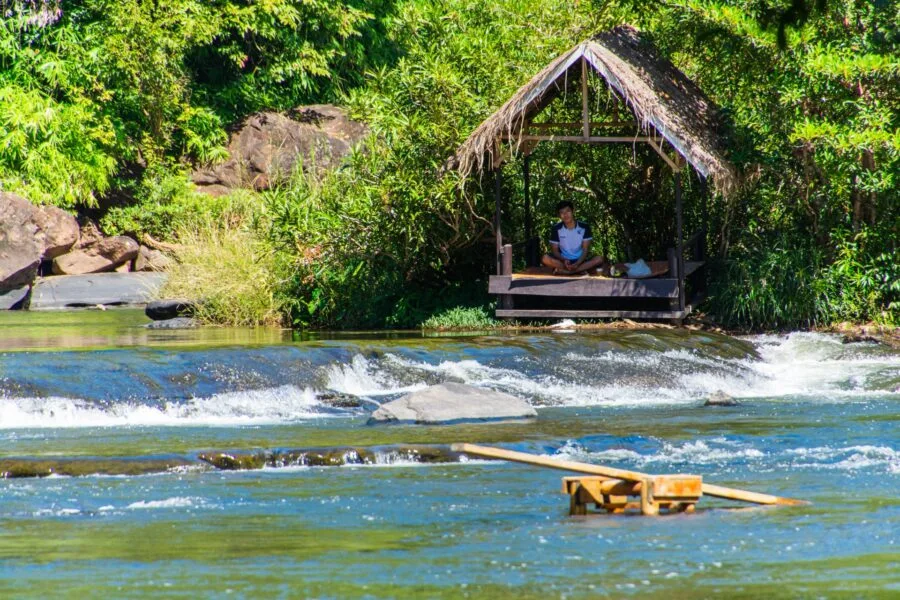
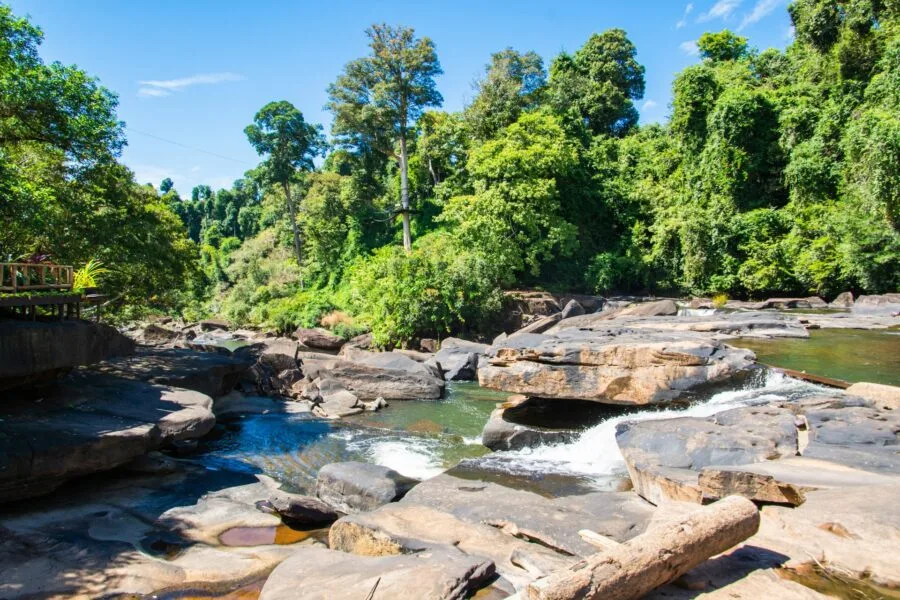

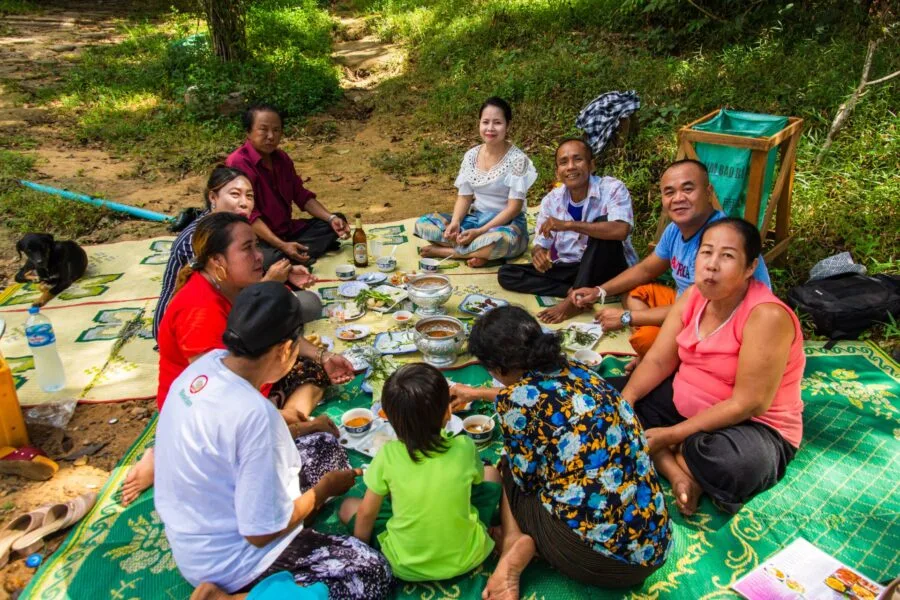
Loop around Champassak: the essentials to remember
- 2 days, it's ideal for enjoying the area without rushing.
- Vat Phou, best done in the morning for light and freshness.
- Don daeng, it's the right plan to slow down. No cars, just nature, villages and a simple life.
- Wat Tomo, if it has a nice side, remains optional in my eyes, to be integrated according to your timing.
- Tad Koy Loy, this is the bonus for those who want a moment of relaxation and refreshment.
- Everything is done without great difficulty, provided you are a little resourceful (especially for the crossing and the waterfall).


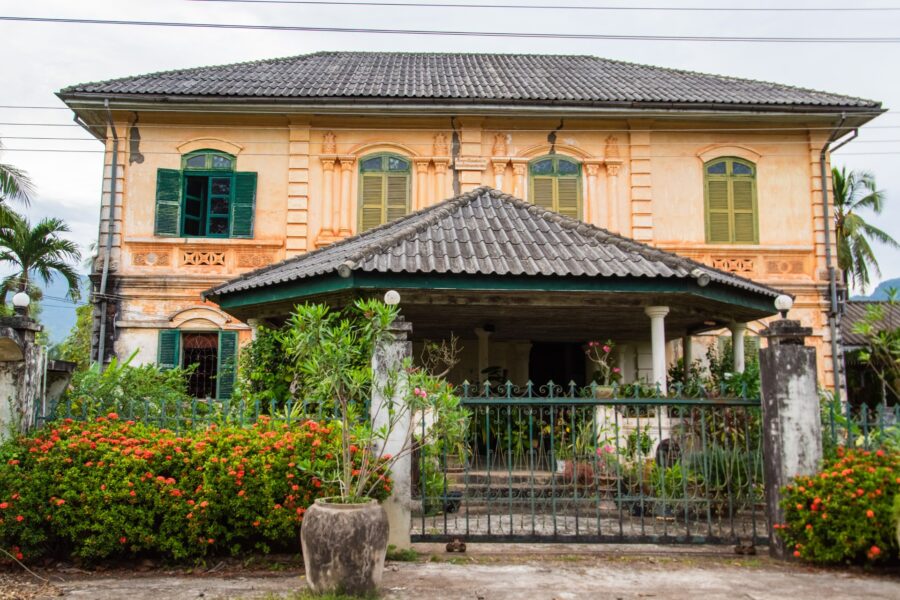
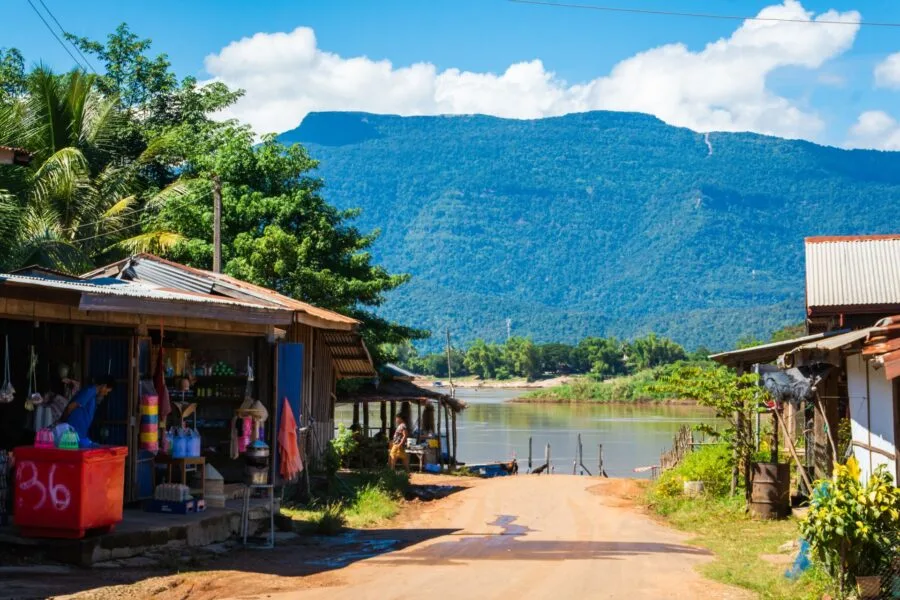
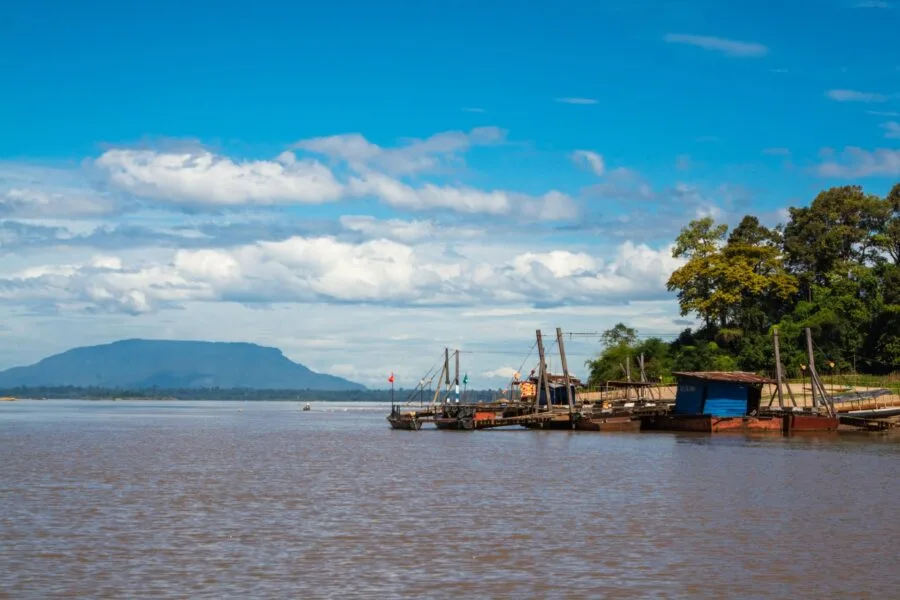
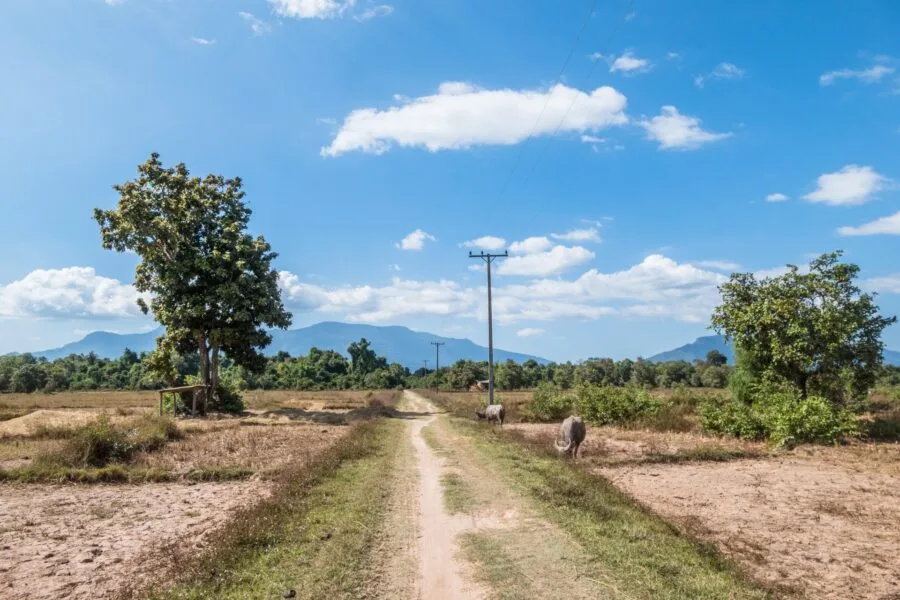

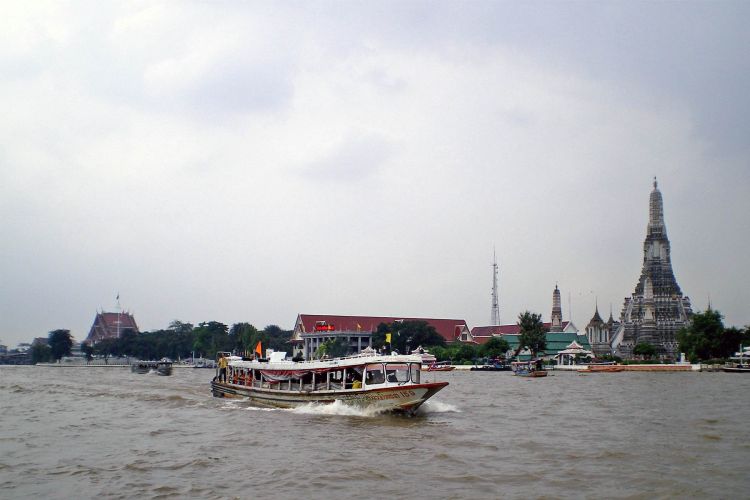

2 Comments
I've been wanting to go to Laos for many years, and I might just take the plunge thanks to this resourceful article! Thanks, Romain.
I'm looking forward to the one on the Bolovens plateau!!
Have a good rest of your trip…
Thank you so much for this message, it's always gratifying to see that we can inspire other people to travel to these lands! I'm currently writing the first article on the Bolovens (there will be two since two stays of two different durations).